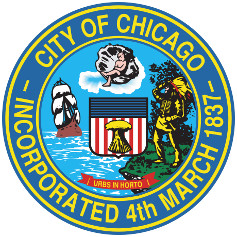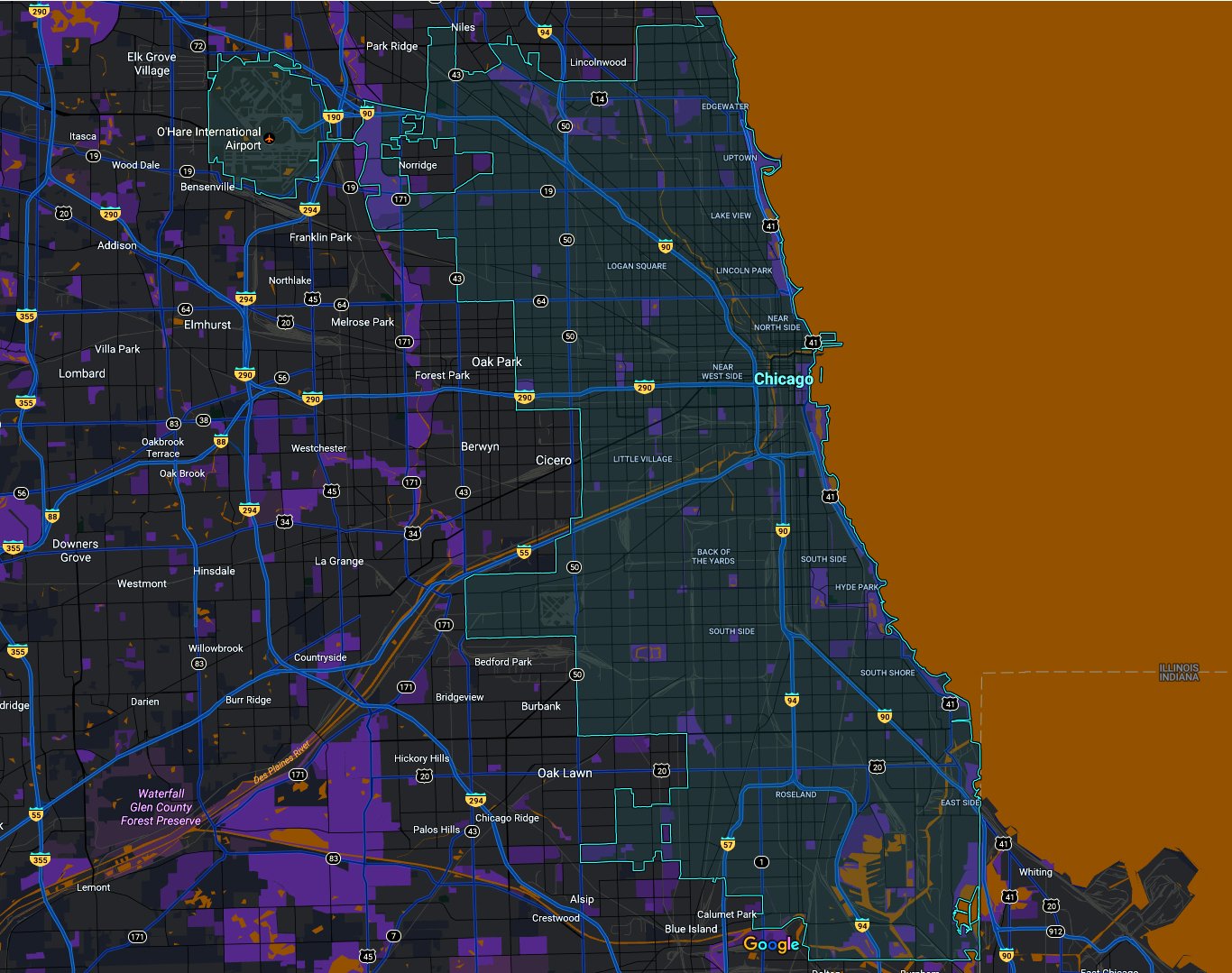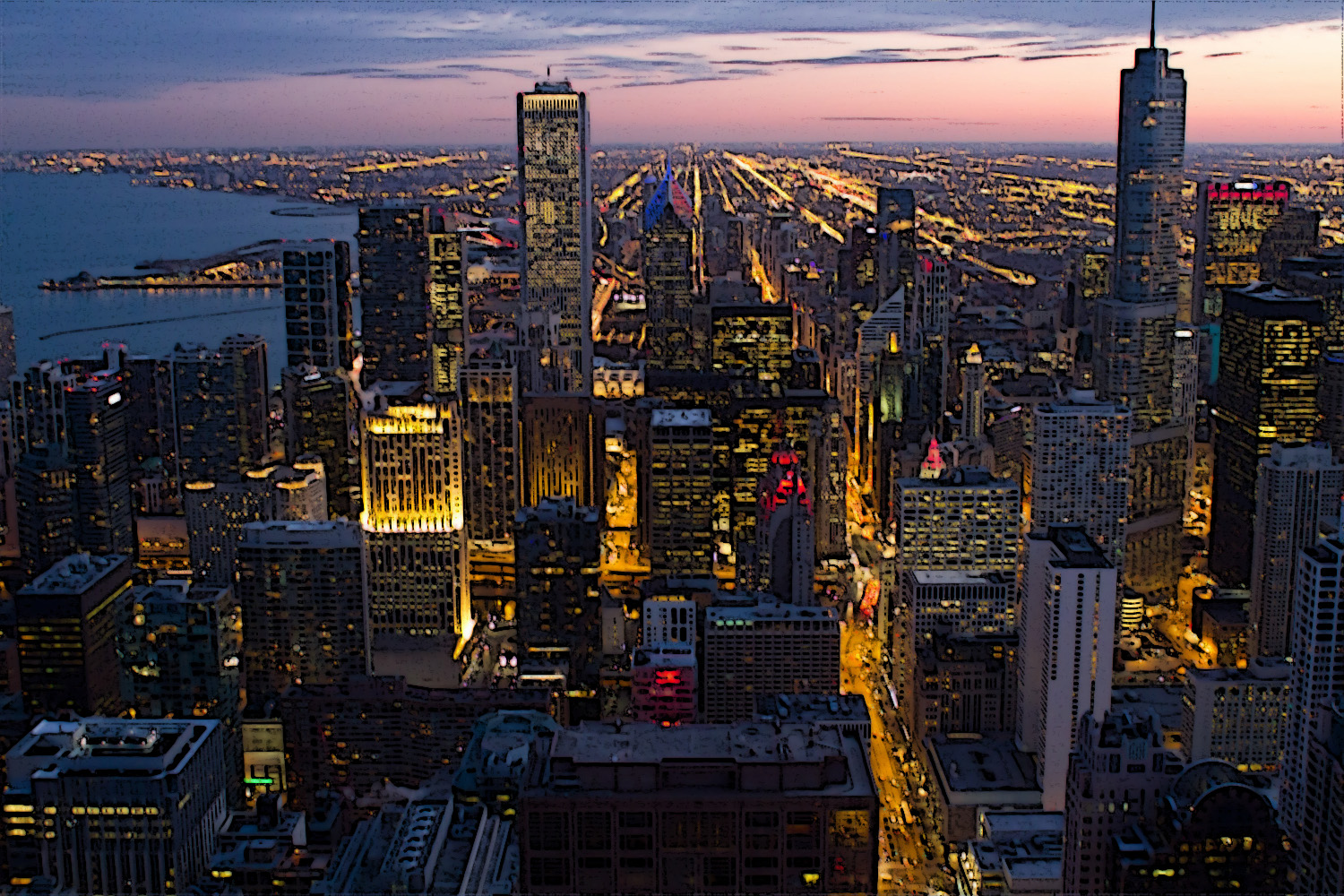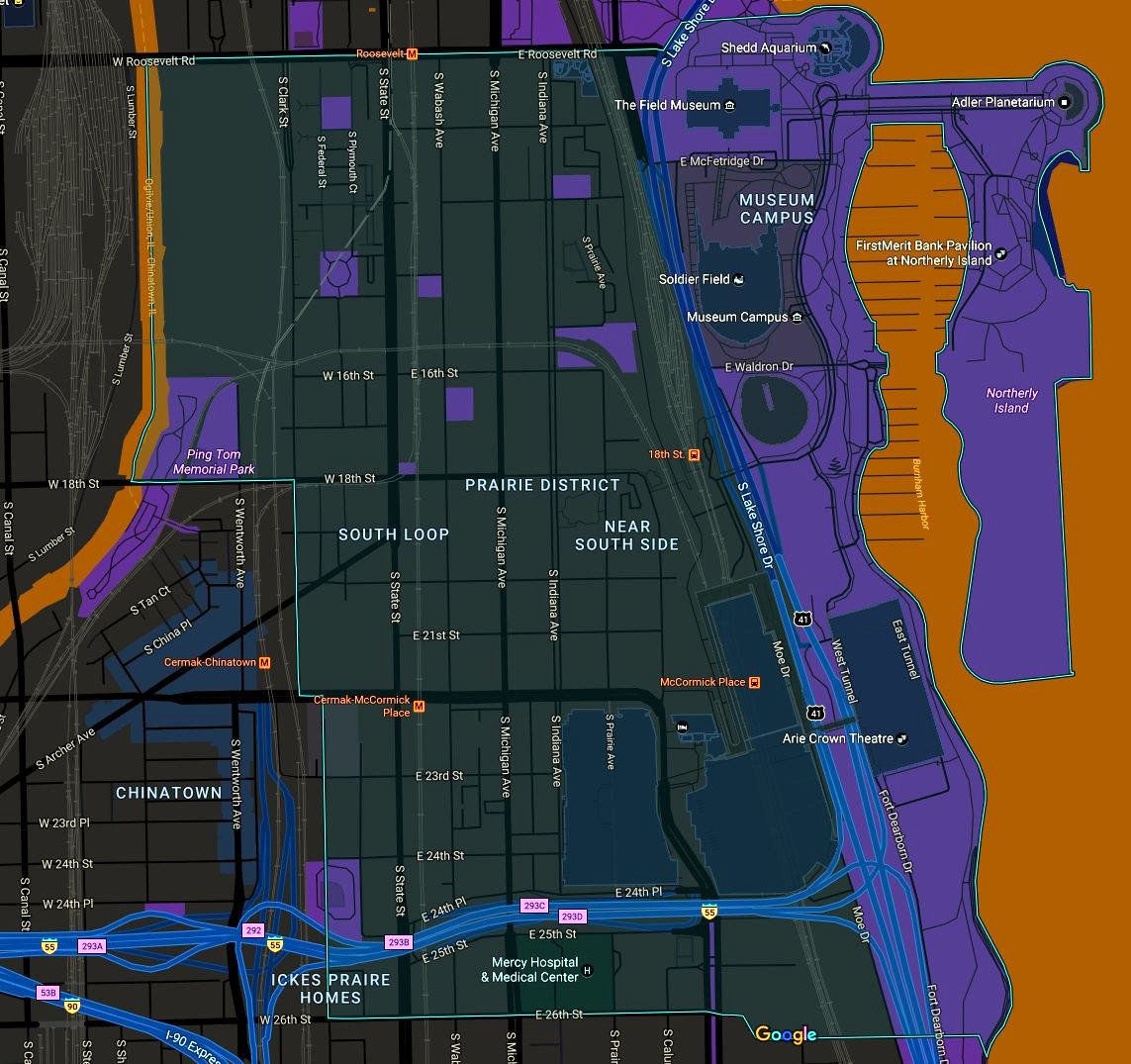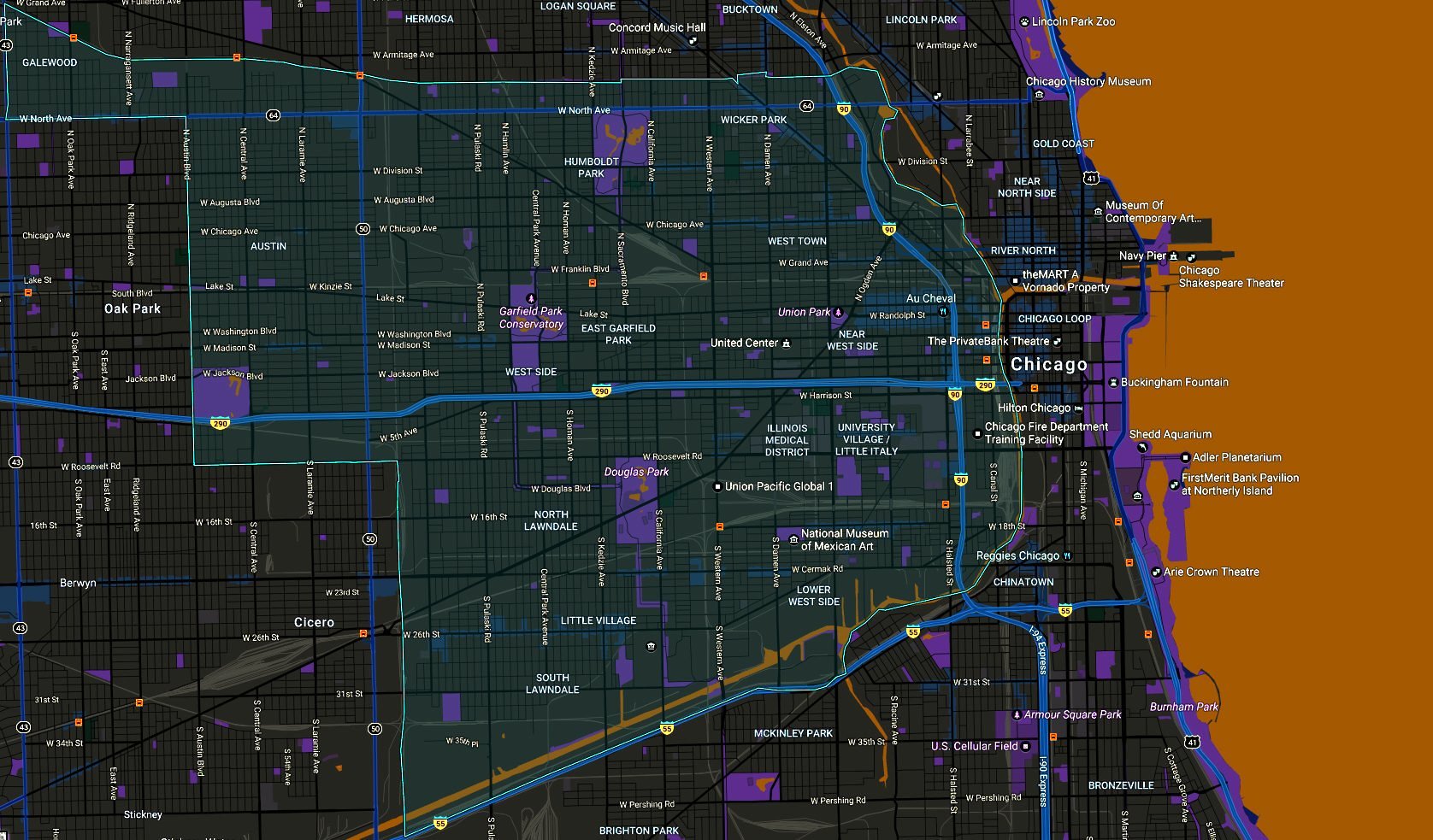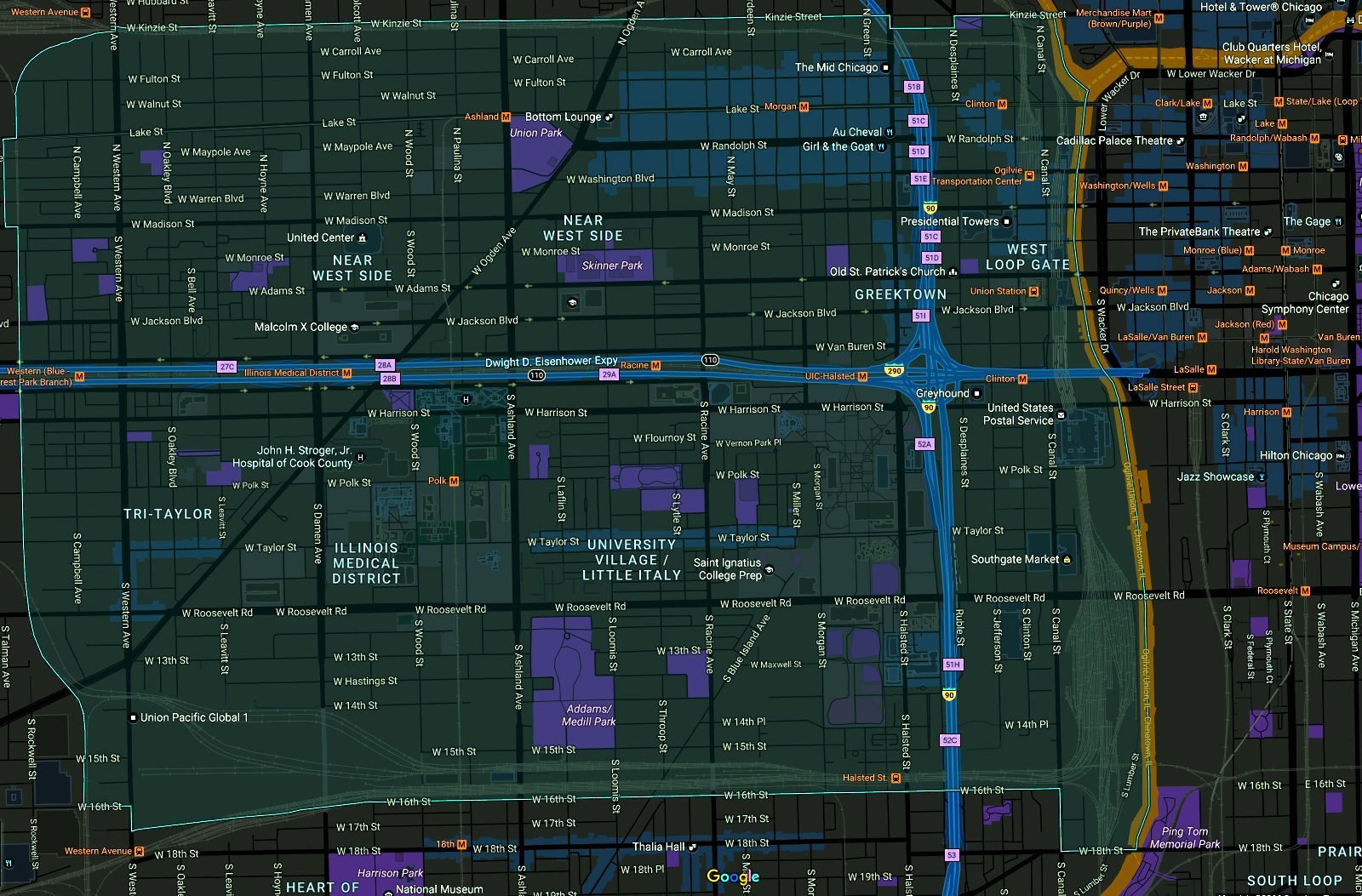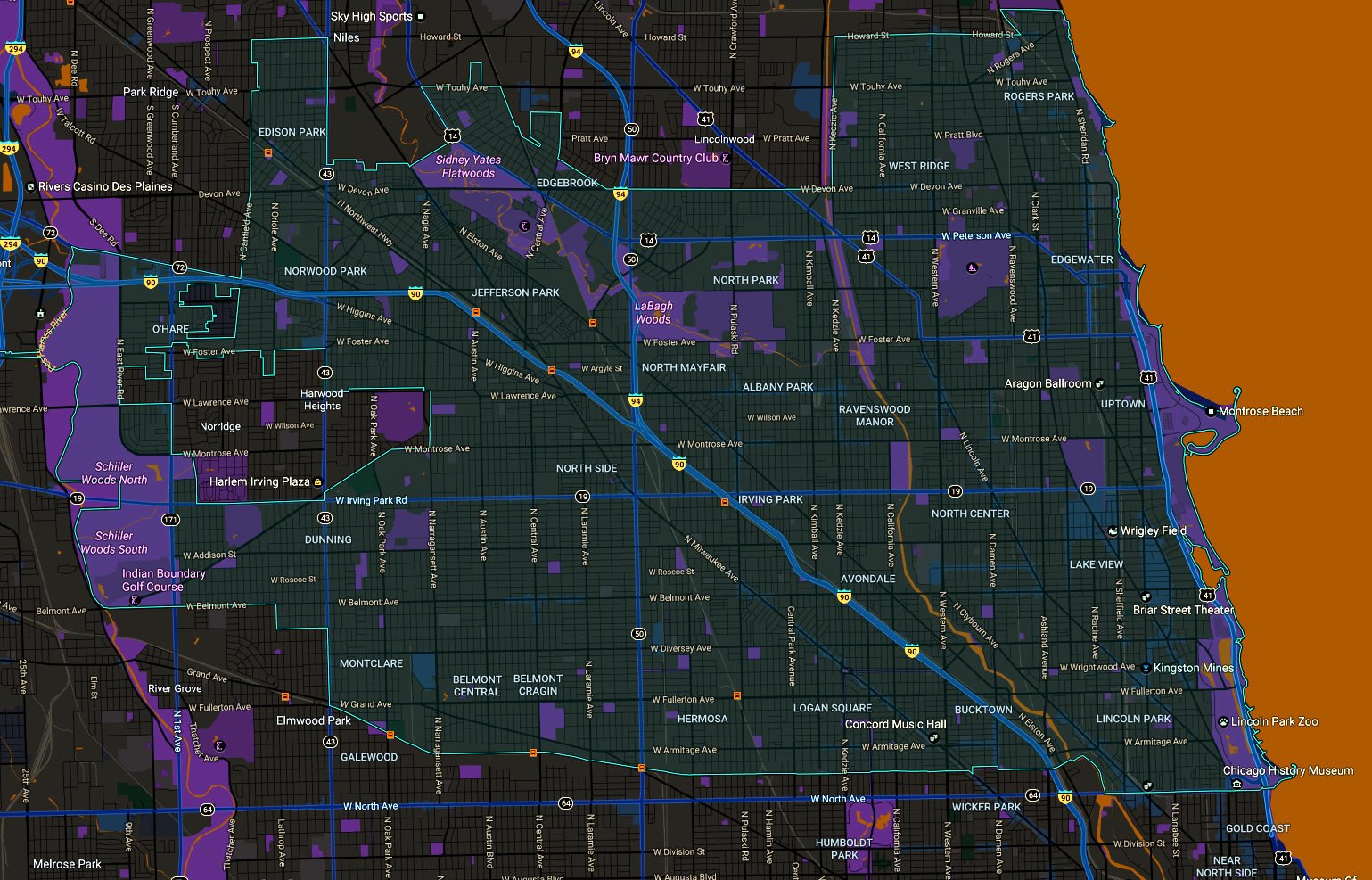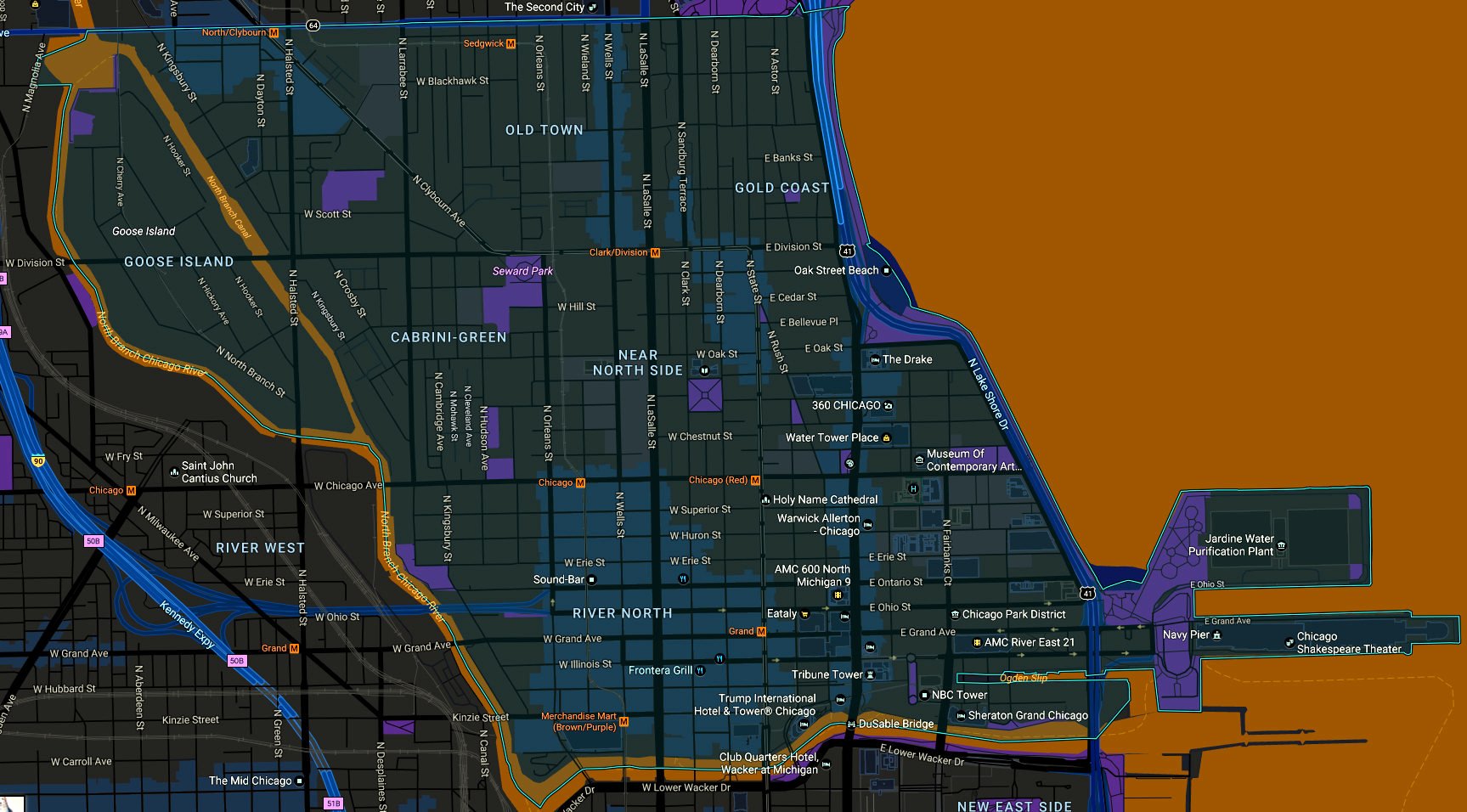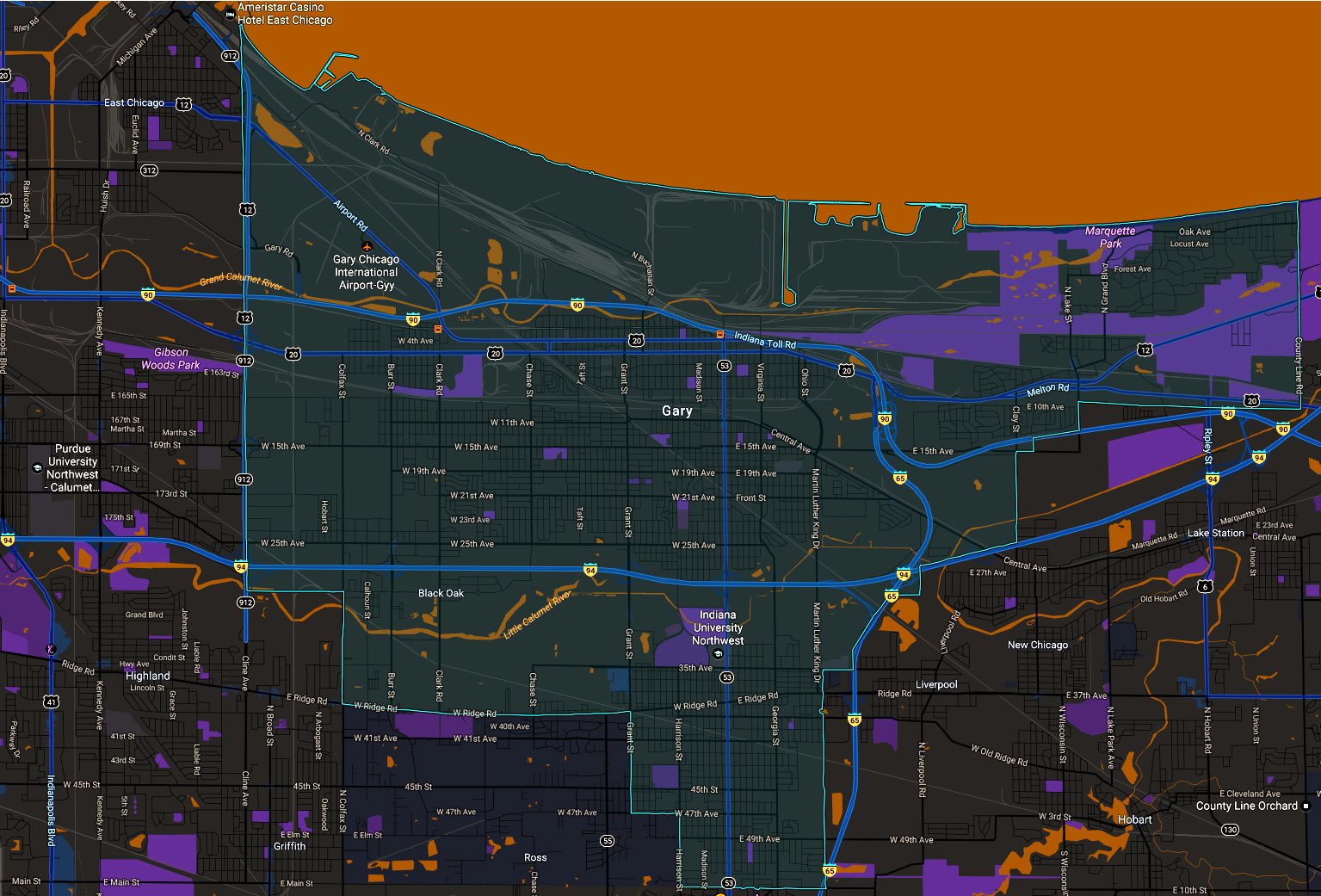Chicago
- Federated American States -x- Gary (Indiana)
Chicago by Day
Quote
At Death's Own Wake...
Chicago, favored city of the Damned, is not as it once was. The streets, which have tasted blood time and time again, feasted as never before during the attack of the savage werewolves. Decades of effort fell in less than a month. That which had been immortal is no more. Crowning this pile of despair is the torn corpse of the prince, the last vestige of immortality ripped out by red-stained claws.
The Dead Can Dance!
The city has become a swirling vortex, pulling in fresh victims from every direction. From across the world the undead swarm, drawn in by Chicago's suffering. Who can resist its desperate call?
Chicago after Dark
City Device
Climate
The city lies within the humid continental climate zone, and experiences four distinct seasons. Summers are warm to hot and often humid, with a July daily average of 75.8 °F (24.3 °C). In a normal summer, temperatures can exceed 90 °F (32 °C) as many as 21 days. Winters are cold and snowy with few sunny days, and the normal January high is just below freezing. Spring and autumn are mild seasons with low humidity. Dewpoint temperatures in the summer range from 55.7 °F (13.2 °C) in June to 61.7 °F (16.5 °C) in July. The city is part of the USDA Plant Hardiness zone 6a, transitioning to 5b in the suburbs.
According to the National Weather Service, Chicago's highest official temperature reading of 105 °F (41 °C) was recorded on July 24, 1934, although Midway Airport reached 109 °F (43 °C) one day prior and recorded a heat index of 125 °F (52 °C) during the 1995 heatwave. The lowest official temperature of −27 °F (−33 °C) was recorded on January 20, 1985, at O'Hare Airport. The city can experience extreme winter cold waves and summer heat waves that may last for several consecutive days. Thunderstorms are common during the spring and summer months which may sometimes produce hail, high winds, and tornadoes. Like other major cities, Chicago also experiences urban heat island, making the city and its suburbs milder than surrounding rural areas, especially at night and in winter. Also, the proximity to Lake Michigan keeps lakefront Chicago cooler in early summer and milder in winter than areas to the west.
Calendar
Demonym
Chicagoan
Districts
Introduction to the Neighborhoods of Chicago
the bowels of the Devil
let me tell you what the sucka eats
its stomach is filled with lost souls
guts made out of steel and concrete.
-- Body Count, "Bowels of the Devil"
Down Town
Introduction to the Loop
The Loop is the central business district of Chicago, Illinois. It is one of the city's 77 designated community areas. The Loop is home to Chicago's commercial core, City Hall, and the seat of Cook County. In the late nineteenth century, cable car turnarounds and prominent elevated railway encircled the area, giving the Loop its name.
The community area is bounded on the north and west by the Chicago River, on the east by Lake Michigan, and on the south by Roosevelt Road, although the commercial core has expanded into adjacent community areas. As a business center, some of the corporations the Loop is home to include the Chicago Mercantile Exchange (CME), the world's largest options and futures contracts open interest exchange; the headquarters of United Continental Holdings, one of the world's largest airlines; AON; Blue Cross Blue Shield; Hyatt Hotels Corporation; BorgWarner, and other major corporations. The Loop is home to 500 acre Grant Park; State Street, which hosts a historic shopping district; the Art Institute of Chicago; several theaters; and numerous subway and elevated rapid transit stations. Other institutions in the Loop include the Willis Tower, once the tallest building in the world, the Chicago Symphony Orchestra, the Lyric Opera of Chicago, the Goodman Theatre, the Joffrey Ballet, the central public Harold Washington Library, and the Chicago Cultural Center.
In what is now the Loop, on the south bank of the Chicago River, near today's Michigan Avenue Bridge, the US Army erected Fort Dearborn in 1803. It was the first settlement in the area sponsored by the United States. In 1908, Chicago addresses were made uniform by naming the intersection of State Street and Madison Street in the Loop as the division point for designating addresses, North, South, East or West on the Chicago street grid.
Etymology
It is believed the origin of the term Loop is derived from the cable car turning loops in the downtown area, and especially those of two lines that shared a loop, constructed in 1882, bounded by Adams, Wabash, Wells, and Lake. Other research has concluded that "the Loop" was not used as a proper noun until after the 1895–97 construction of the Union elevated railway loop.
Attractions
Loop architecture has been dominated by skyscrapers and high-rises since early in its history. Notable buildings include the Home Insurance Building, considered the world's first skyscraper (demolished in 1931); the Chicago Board of Trade Building, a National Historic Landmark; and Willis Tower, the world's tallest building for nearly 25 years. Some of the historic buildings in this district were instrumental in the development of towers. Chicago's street numbering system – dividing addresses into North, South, East, and West quadrants originates in the Loop at the intersection of State Street and Madison Street.
Chicago is still the nation's rail transportation hub and passenger lines once reached seven Loop-area stations by the 1890s. Transfers from one to the other was a major business for taxi drivers until the long-distance lines gave way to Amtrak in the 1970s with the majority of trains concentrated at Chicago Union Station.
This area abounds in shopping opportunities, including the Loop Retail Historic District, although it competes with the more upscale Magnificent Mile area to the north. It includes Chicago's former Marshall Field's department store location in the Marshall Field and Company Building; the original Sullivan Center Carson Pirie Scott store location (closed February 21, 2007). Chicago's Downtown Theatre District is also found within this area, along with numerous restaurants and hotels.
Chicago has a famous skyline which features many of the tallest buildings in the world as well as the Chicago Landmark Historic Michigan Boulevard District. Chicago's skyline is spaced out throughout the downtown area, giving it a graceful beautiful appearance. The Willis Tower, formerly known as the Sears Tower, the second tallest building in the Western Hemisphere, stands in the western Loop in the heart of the city's financial district, along with other buildings, such as 311 South Wacker Drive and the AT&T Corporate Center.
Chicago's third tallest building, the Aon Center, is located just south of Illinois Center. The complex is at the east end of the Loop, east of Michigan Avenue. Two Prudential Plaza is also located here, just to the west of the Aon Center.
The Loop contains a wealth of outdoor sculpture, including works by Pablo Picasso, Joan Miró, Henry Moore, Marc Chagall, Magdalena Abakanowicz, Alexander Calder, and Jean Dubuffet. Chicago's cultural heavyweights, such as the Art Institute of Chicago, the Goodman Theatre, the Chicago Theatre, the Lyric Opera at the Civic Opera House building, and the Chicago Symphony Orchestra, are also in this area, as is the historic Palmer House Hilton hotel, found on East Monroe Street.
Chicago's waterfront, which is almost exclusively recreational beach and park areas from north to south, features Grant Park in the downtown area. Grant Park is the home of Buckingham Fountain, the Petrillo Music Shell, the Grant Park Symphony (where free concerts can be enjoyed throughout the summer), and Chicago's annual two-week food festival, the Taste of Chicago, where more than 3 million people try foods from over 70 vendors. The area also hosts the annual music festival Lollapalooza which features popular alternative rock, heavy metal, EDM, hop hop and punk rock artists. Millennium Park, which is a section of Grant Park, opened in the summer of 2004 and features Frank Gehry's Jay Pritzker Pavilion, Jaume Plensa's Crown Fountain, and Anish Kapoor's Cloud Gate sculpture along Lake Michigan.
The Chicago River and its accompanying Chicago Riverwalk, which delineates the area, also provides entertainment and recreational opportunities, including the annual dyeing of the river green in honor of St. Patrick's Day. Trips down the Chicago River, including architectural tours, by commercial boat operators are great favorites with both locals and tourists alike.
City Government
The Loop is the seat of Chicago's government. It is also the government seat of Cook County, Illinois and houses an office for the governor of the State of Illinois. The century old City Hall/County Building houses the chambers of the Mayor, City Council and County Board.
Across the street, the Richard J. Daley Center accommodates a famous Picasso sculpture and the state law courts. Given its proximity to government offices, the Center's plaza serves as a kind of town square for celebrations, protests and other events.
The nearby James R. Thompson Center is the city headquarters for state government, with an office for the Governor. Many state agencies have offices here, including the Illinois State Board of Education.
A few blocks away is the Everett McKinley Dirksen United States Courthouse housing federal law courts and other federal government offices. This is the seat of the United States Court of Appeals for the Seventh Circuit. The Kluczynski Federal Building is across the street. The Federal Reserve Bank of Chicago is located on LaSalle Street in the heart of the financial district. The United States Postal Service operates the Loop Station Post Office at 211 South Clark Street.
The Fire Department
The Chicago Fire Department operates 3 Fire Stations in the Loop District:
- -- Engine 1, Aerial Tower 1, Ambulance 41 – 419 S. Wells St. – South Loop
- -- Engine 5, Truck 2, Special Operations Battalion 5-1-5, Collapse Unit 5-2-1 – 324 S. Des Plaines St. – West Loop/Near West Side
- -- Engine 13, Truck 6, Battalion 1, EMS Field Chief 4-5-1, Dive Master 6-8-6, SCUBA Team 6-8-7 – 259 N. Columbus Dr. – East Loop/Near East Side
Neighborhoods
According to the 2010 census, 29,283 people live in the neighborhoods in or near the Loop. The median sale price for residential real estate was $710,000 in 2005 according to Forbes. In addition to the government, financial, theater and shopping districts, there are neighborhoods that are also part of the Loop community area.
New Eastside
The New Eastside is a mixed-use district bordered by Michigan Avenue to the west, the Chicago River to the north, Randolph Street to the south, and Lake Shore Drive to the east. It encompasses the entire Illinois Center and Lakeshore East is the latest lead-developer of the 1969 Planned Development #70, as well as separate developments like Aon Center, Prudential Plaza, Park Millennium Condominium Building, Hyatt Regency Chicago, and the Fairmont Hotel. The area has a triple-level street system and is bisected by Columbus Drive. Most of this district has been developed on land that was originally water and once used by the Illinois Central Railroad rail yards. The early buildings in this district such as the Aon Center and One Prudential Plaza used airspace rights in order to build above the rail-yards. The New Eastside Association of Residents (NEAR) has been the recognized community representative (Illinois non-profit corporation) since 1991 and is a 501(c)(3) IRS tax-exempt organization.
The triple-level street system allows for trucks to mainly travel and make deliveries on the lower levels, keeping traffic to a minimum on the upper levels. Through north-south traffic uses Middle Columbus and the bridge over the Chicago River. East-west through traffic uses either Middle Randolph or Upper and Middle Wacker between Michigan Avenue and Lake Shore Drive.
Printer's Row
Printer's Row, also known as Printing House Row, is a neighborhood located in the southern portion of the Loop community area of Chicago. It is centered on Dearborn Street from Congress Parkway on the north to Polk Street on the south, and includes buildings along Plymouth Court on the east and Federal Street to the west. Most of the buildings in this area were built between 1886 and 1915 for house printing, publishing, and related businesses. Today, the buildings have mainly been converted into residential lofts. Part of Printer's Row is an official landmark district, called the Printing House Row District. The annual Printers Row Lit Fest is held in early June along Dearborn Street.
South Loop
Dearborn Station at the south end of Printers Row, is the oldest train station still standing in Chicago; it has been converted to retail and office space. Most of the area south of Congress Parkway between Lake Michigan and the Chicago River, excepting Chinatown, is referred to as the South Loop. Perceptions of the southern boundary of the neighborhood have changed as development spread south, and the name is now used as far south as 26th Street.
The neighborhood includes former rail-yards that have been redeveloped as new-town-in-town such as Dearborn Park and Central Station. Former warehouses and factory lofts have been converted to residential buildings, while new townhouses and high-rises have been developed on vacant or underused land. A major landowner in the South Loop is Columbia College Chicago, a private school that owns 17 buildings.
South Loop is zoned to the following Chicago Schools: South Loop School and Phillips Academy High School. Jones College Prep High School, which is a selective enrollment prep school drawing students from the entire city, is also located in the South Loop.
The South Loop was historically home to vice districts, including the brothels, bars, burlesque theaters, and arcades. Inexpensive residential hotels on Van Buren and State Street made it one of the city's Skid Rows until the 1970s. One of the largest homeless shelters in the city, the Pacific Garden Mission, was located at State and Balbo from 1923 to 2007, when it moved to 1458 S. Canal St.
Historic Michigan Boulevard District
The Loop also contains the Chicago Landmark Historic Michigan Boulevard District, which is the section of Michigan Avenue opposite Grant Park and Millennium Park. Historical images and current architecture of the Chicago Loop can be found in Explore Chicago Collections, a digital repository made available by Chicago Collections archives, libraries and other cultural institutions in the city.
The Economy of the Loop
The Loop, along with the rest of downtown Chicago, is the second largest commercial business district in the United States, after New York City's Midtown Manhattan. Its financial district near LaSalle Street is home to the CME Group's Chicago Board of Trade and Chicago Mercantile Exchange.
Aon Corporation maintains its headquarters in the Aon Center. Chase Bank has its commercial and retail banking headquarters in Chase Tower. Exelon also has its headquarters in the Chase Tower. United Airlines has its headquarters in Willis Tower. United moved its headquarters to Chicago from Elk Grove Township, Illinois in early 2007. In addition, United's parent company, United Continental Holdings, also has its headquarters in Willis Tower. Blue Cross and Blue Shield Association has its headquarters in the Michigan Plaza complex. Sidley Austin and Morton Salt are both headquartered in the Loop.
The Chicagoland Chamber of Commerce is located in an office in the Aon Center, the French-American Chamber of Commerce in Chicago has an office in 35 East Wacker, the Netherlands Chamber of Commerce in the United States is located in an office at 303 East Wacker Drive, and the US Mexico Chamber of Commerce Mid-America Chapter is located in an office in One Prudential Plaza.
Previously the grocery store company Red & White had its headquarters in the Loop. McDonald's was headquartered in the Loop until 1971, when it moved to Oak Brook, Illinois. When Bank One Corporation existed, its headquarters were in the Bank One Plaza (now Chase Tower). When Amoco existed, its headquarters were in the Amoco Building (now the Aon Center).
Diplomatic missions
Several countries maintain consulates in the Loop. They include Argentina, Australia, Brazil, Canada, Costa Rica, the Czech Republic, Ecuador, El Salvador, France, Guatemala, Haiti, India, Indonesia, Israel, The Republic of Korea, the Republic of Macedonia, the Netherlands, Pakistan, Peru, the Philippines, South Africa, Turkey, and Venezuela. In addition, the Taipei Economic and Cultural Office of the Republic of China is in the Loop.
Colleges and Universities
Columbia College Chicago, Roosevelt University, and Tribeca Flashpoint Media Arts Academy are all located in the Loop. DePaul University also has a campus in the Loop. The University of Notre Dame & University of Illinois at Urbana-Champaign run their EMBA programs in their Chicago Campuses in the Loop.
National-Louis University is located in the historic Peoples Gas Building on Michigan Avenue across the street from the Art Institute of Chicago. The School of the Art Institute of Chicago, one of the nation's largest independent schools of art and design, is headquartered in Grant Park.
Harold Washington College is a City Colleges of Chicago community college located in the Loop. Adler School of Professional Psychology is a college located in the Loop.
Robert Morris University is located here. Argosy University has its head offices on the thirteenth floor of 205 North Michigan Avenue in Michigan Plaza. Harrington College of Design is located at 200 West Madison Street after relocating from the Merchandise Mart. Trinity Christian College offers an accelerated teaching certification program at 1550 S. State Street in the South Loop.
Spertus Institute, a center for Jewish learning & culture, is located at 610 S. Michigan Ave. Graduate level courses (Master and Doctorate) are offered in Jewish Studies, Jewish Professional Studies and Non-profit Management. Also housed in the Spertus building is Meadville Lombard Theological School which is affiliated with the Unitarian Universalist Association, a liberal, progressive seminary offering graduate level theological and ministerial training. East-West University is located at 816 S Michigan Ave.
Notable Landmarks
- -- Chicago's Agora -- A group of sculptures at the south end of Grant Park.
- -- Art Institute of Chicago
- -- Auditorium Building
- -- Buckingham Fountain
- -- Carbide & Carbon Building
- -- Carson, Pirie, Scott and Company Building
- -- Chicago Board of Trade Building
- -- Chicago Theatre
- -- Chicago Cultural Center
- -- Chicago City Hall
- -- Civic Opera House
- -- Field Building
- -- Fine Arts Building
- -- Grant Park
- -- Jewelers Row District
- -- Mather Tower
- -- McCormick Place
- -- Historic Michigan Boulevard District
- -- Monadnock Building
- -- The Palmer House
- -- Printing House Row
- -- Reliance Building
- -- Rookery Building
- -- Symphony Center – home of the Chicago Symphony Orchestra
- -- Willis Tower – formerly the Sears Tower
East Side
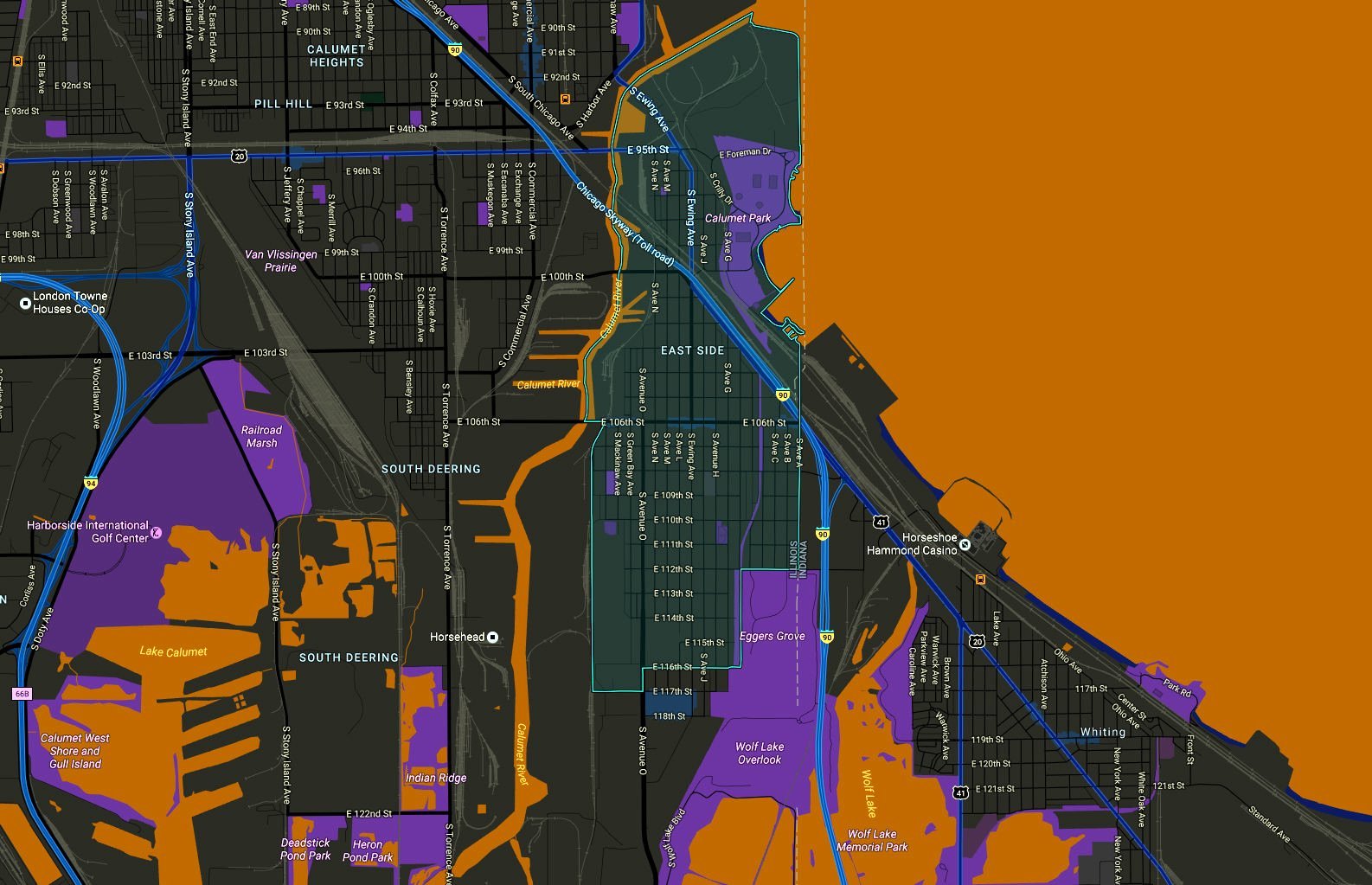
East Side is one of the 77 official community areas of Chicago, Illinois. It is located on the far south side of the city, between the Calumet River and the Illinois-Indiana state line, approximately 13 miles (21 km) south of Downtown Chicago. The neighborhood has its own park on Lake Michigan, Calumet Park, and its own forest preserve, Eggers Grove Forest Preserve, which neighborhood residents usually call Eggers Woods. It is served by U.S. Highway 12, U.S. Highway 20, and U.S. Highway 41, which are multiplexed in this neighborhood.
Boundaries
East Side is bounded by Calumet River to the North and West, State Line Road (4100 E) to the East, and 126th street (12600 S) to the South.
History
The East Side, until recently, was socially and economically dominated by the Calumet River and the jobs it supported. The community got its name from the river because it was located on its east bank. The river formed the once-thriving industrial Port of Chicago. A cluster of riverside docks and slips allowed materials of all sorts to be loaded and unloaded onto adjacent railroad lines, and the river itself was lined with steel mills. Republic Steel began operations here in 1901. The Republic mill was the site of frequent union unrest, culminating in the Memorial Day Massacre of 1937 and the successful drive by the United Steelworkers to organize the Chicago mills.
Many of the neighborhood's residents during this period were families of Slovenia, Croatian and Serbian heritage, who had emigrated from Europe to work in the steel mills and take related jobs. Especially after unionization, the neighborhood became a stronghold of the Chicago Democratic Party machine of Mayor Richard J. Daley. The neighborhood's longtime alderman, Edward Vrdolyak, became a noted Chicago "power broker" after the senior Daley's death. Today, the area is largely Hispanic.
In the 1950s, the East Side was divided in two by the Chicago Skyway. The riverside steel mills and heavy industries went into serious decline in 1970-2000, and are no longer the mainstay of the neighborhood.
Other Details
Much of East Side's homes are the Chicago-style bungalow, and the southeast portion of East Side contains many newer homes (including some bungalows) built after 1980. Currently, there are proposed plans to expand East Side's Calumet Park and Beach, and to extend the existing lakefront bicycle path to the proposed new lakefront parklands in adjacent South Chicago. This proposed future expansion of Chicago's southern lakefront parklands will result in the connection of Calumet Park to Rainbow Beach, the South Shore Cultural Center, and Jackson Park.
Sites of Interest
- -- Calumet Park and Beach
- -- Chicago Skyway
- -- George Washington High School of Chicago
- -- Port of Chicago
- -- Republic Steel
- -- St. Francis de Sales High School of Chicago
South Side
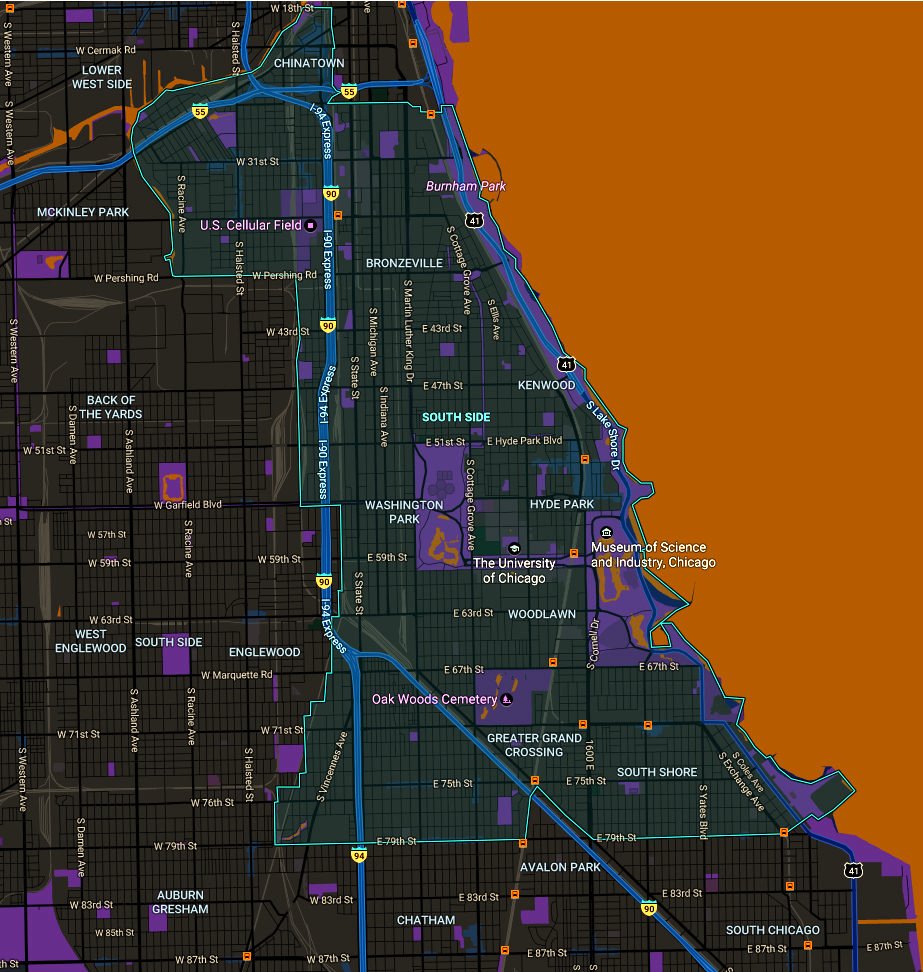
The South Side is the largest section of the city, encompassing roughly 60% of the city's land area, and much was annexed in the late 19th century. The section along the lake is marked with public parkland and beaches. The South Side has a higher ratio of single-family homes and also contains most of the city's remaining industry. Historically it was the location of the stockyards, and its industries attracted hundreds of thousands of European immigrants and African-American migrants in the late 19th and early 20th centuries. More recent immigrants have come from Mexico and Latin America. The Chicago White Sox have played at three different stadiums in the area since 1900—first South Side Park (1900–1910), then the original Comiskey Park (1910–1990), and finally their current home, originally named Comiskey Park but now known as U.S. Cellular Field (1991–present).
Along with being the largest section of the city in terms of geography, the South Side is also home to one of the city's largest parades: the annual Bud Billiken Day parade. Held during the second weekend of August, it celebrates children returning to school.
The South Side has two of Chicago's largest public parks. Jackson Park, which hosted the World's Columbian Exposition in 1893, is the site of the Museum of Science and Industry. The park stretches along the waterfront, situated between the neighborhoods of Hyde Park and South Shore. Washington Park sits slightly west of Jackson Park and the two are connected by a strip of parkland known as Midway Plaisance, which runs parallel to the University of Chicago.
Community Areas
- -- Armour Square -- is a Chicago neighborhood on the city's South Side, as well as a larger, officially defined community area which also includes Chinatown and the CHA Wentworth Gardens housing project. Armour Square is bordered by Bridgeport to the west and Bronzeville to the east, with Pilsen and the near South Side bordering the area to the north and Fuller Park bordering its southernmost boundary along Pershing Road.
Neighborhoods
- -- Bronzeville -- is a neighborhood in the Douglas and Grand Boulevard community areas on the South Side of Chicago around the Illinois Institute of Technology, VanderCook College of Music, and Illinois College of Optometry. It is accessible via the Green and Red lines of the Chicago Transit Authority, as well as the Metra Electric District Main Line.
- -- Legends South -- is a mixed-income housing development located in the Bronzeville neighborhood of the South Side of Chicago. It will include nearly 2,400 new mixed-income rental and home ownership units. In 1996 HOPE VI funds were granted specifically for Legends South to replace the infamous Robert Taylor Homes.
- -- Hyde Park, Chicago -- Hyde Park is a neighborhood and community area on Chicago's South Side. It is located on the shore of Lake Michigan seven miles (11 km) south of the Chicago Loop.
Near South Side
West Side
Near West Side
North Side
Near North Side
Cabrini Green
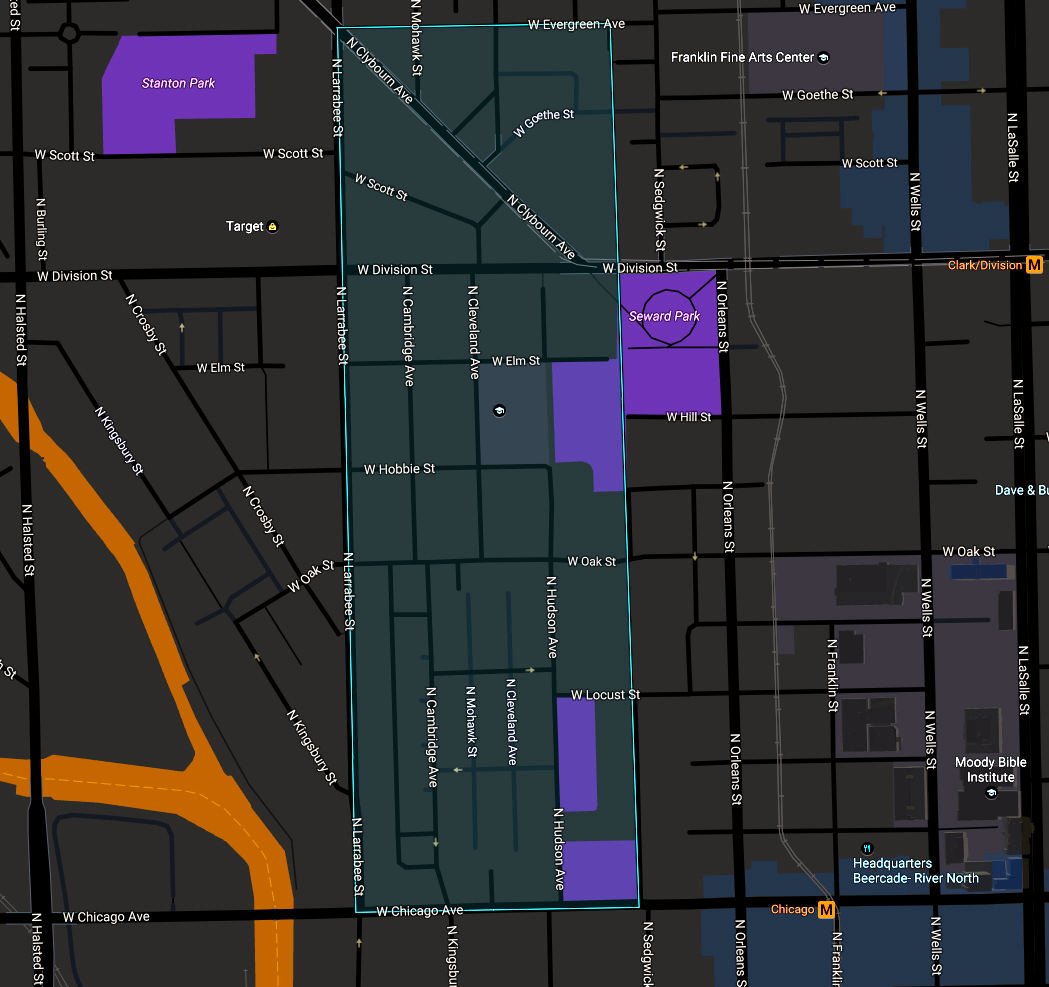
Cabrini–Green Homes (Frances Cabrini Row-houses and William Green Homes) was a Chicago Housing Authority (CHA) public housing project located on the Near North Side of Chicago, Illinois, United States. It was bordered by the apex of Clybourn Ave and Halsted Street on the north, North Larrabee Street on the west, Chicago Avenue on the south, Hudson Street on the east. Today, only a small set of row houses, built in the 1940s, remain (south of Oak Street, north of Chicago Avenue, west of Hudson Avenue, and east of Larrabee Street).
At its peak, Cabrini–Green was home to 15,000 people, living in mid- and high-rise apartment buildings totaling 3,607 units. Over the years, crime, gang violence and neglect created deplorable living conditions for the residents, and "Cabrini–Green" became synonymous with the problems associated with public housing in the United States. The last of the buildings in Cabrini–Green was demolished in March 2011. The Near North Side site formerly home to the William Green projects has been undergoing major redevelopment since the late 1990s, resulting in a combination of upscale high-rise buildings and row houses, with the stated goal of creating a mixed-income neighborhood, with some units still being reserved for public housing tenants. Controversy regarding the implementation of such plans has arisen (due to the crime element within remaining row houses), though slated redevelopment plans are now set to move forward following the September 2015 settlement of a longstanding civil lawsuit.
The Outlands
Specific Locations
The Suburbs
Gary, Indiana
Economy
History
"They only dimly recalled the things they had lost and refused to believe that there had been a time when they were pure and happy." -- Fyoder Dostoyevsky, The Dream of a Ridiculous Man
Chicago has earned itself a host of colorful sobriquets during its short but illustrious history. Young by European standards, the city has become known as "Gangsterland", "Hog Butcher" and the "Windy City", among other names. Its political machine has long been one of the most powerful in the country, manipulating politics even at a national level. However, none of these images tell the whole story about one of America's most intriguing municipalities. The truth is concealed in the unlives of the Kindred who control this city, and who have manipulated its history from its very first days.
Introduction
The history of Chicago, Illinois, has played a central role in American economic, social, cultural and political history and since the 1850s has been the dominant Midwest metropolis. The area's recorded history begins with the arrival of French explorers, missionaries and fur traders in the late 17th century and their interaction with the local Potawatomi Indians. There were small settlements and a U.S. Army fort, but the soldiers and settlers were all driven off in 1812. The modern city was incorporated in 1837 by Northern businessmen and grew rapidly from real estate speculation and the realization that it had a commanding position in the emerging inland transportation network, based on lake traffic and railroads, controlling access from the Great Lakes into the Mississippi River basin. Despite a fire in 1871 that destroyed the central business district, the city grew exponentially, becoming the nation's rail center and the dominant Midwestern center for manufacturing, commerce, finance, higher education, religion, broadcasting, sports, jazz, and high culture. The city was a magnet for European immigrants—at first Germans, Irish and Scandinavians, then from the 1890s to 1914, Jews, Czechs, Poles and Italians. They were all absorbed in the city's powerful ward-based political machines. Many joined militant labor unions, and Chicago became notorious for its violent strikes, and high wages. Large amounts of African Americans migrated from the South in starting in the World War I era as part of the Great Migration. Mexicans started arriving after 1910, and Puerto Ricans after 1945. The Cook County suburbs grew rapidly after 1945, but the Democratic party machine kept both the city and suburbs under control, especially under mayor Richard J. Daley, who was chairman of the Cook County Democratic Party. Deindustrialization after 1970 closed the stockyards and most of the steel mills and factories, but the city retained its role as a financial and transportation hub. Increasingly it emphasized its service roles in medicine, higher education and tourism. The city formed the political base for national leaders of the Democratic Party, especially Stephen A. Douglas in the 1850s, Adlai Stevenson in the 1950s, and Barack Obama in recent years.
Original Native Settlements
At its first appearance in records by explorers, the Chicago area was inhabited by a number of Algonquian peoples, including the Mascouten and Miami. The name "Chicago" is derived from a French rendering of the Native American word shikaakwa, known to botanists as Allium tricoccum, from the Miami-Illinois language. The first known reference to the site of the current city of Chicago as "Checagou" was by Robert de LaSalle around 1679 in a memoir. Henri Joutel, in his journal of 1688, noted that the wild garlic, called "chicagoua", grew abundantly in the area. According to his diary of late September 1687: "when we arrived at the said place called Chicagou which, according to what we were able to learn of it, has taken this name because of the quantity of garlic which grows in the forests in this region."
The tribe was part of the Miami Confederacy, which included the Illini and Kickapoo. In 1671, Potawatomi guides first took the French trader Nicolas Perrot to the Miami villages near the site of present-day Chicago. Pierre François Xavier de Charlevoix would write in 1721 that the Miami had a settlement in what is now Chicago around 1670. Chicago's location at a short canoe portage (the Chicago Portage) connecting the Great Lakes with the Mississippi River system attracted the attention of many French explorers, notably Louis Jolliet and Jacques Marquette in 1673. The Jesuit Relations indicate that by this time, the Iroquois tribes of New York had driven the Algonquian tribes entirely out of Lower Michigan and as far as this portage, during the later Beaver Wars.
René-Robert Cavelier, Sieur de La Salle, who traversed the Kankakee and Illinois Rivers south of Chicago in the winter of 1681–82, identified the Des Plaines River as the western boundary of the Miami. In 1683, La Salle built Fort St. Louis on the Illinois River. Almost two thousand Miami, including Weas and Piankeshaws, left the Chicago area to gather on the opposite shore at the Grand Village of the Illinois, seeking French protection from the Iroquois. In 1696, French Jesuits led by Jean-François Buisson de Saint-Cosme built the Mission of the Guardian Angel to Christianize the local Wea and Miami people. Shortly thereafter, Augustin le Gardeur de Courtemanche visited the settlement on behalf of the French government, seeking peace between the Miami and Iroquois. Miami chief Chichikatalo accompanied de Courtemanche to Montreal.
The Algonquian tribes began to retake the lost territory in the ensuing decades, and in 1701 the Iroquois formally abandoned their claim to their "hunting grounds" as far as the portage to England in the Nanfan Treaty, which was finally ratified in 1726. This was largely a political maneuver of little practicality, as the English then had no presence in the region whatsoever, the French and their Algonquian allies being the dominant force in the area. A writer in 1718 noted at the Was had a village in Chicago, but had recently fled due to concerns about approaching Ojibwes and Pottawatomis. The Iroquois and Meskwaki probably drove out all Miami from the Chicago area by the end of the 1720s. The Pottawatomi assumed control of the area, but probably did not have any major settlements in Chicago. French and allied use of the Chicago portage was mostly abandoned during the 1720s because of continual Native American raids during the Fox Wars.
European Arrival
The first settler in Chicago was Jean Baptiste Point du Sable who built a farm at the mouth of the Chicago River in the 1780s. He left Chicago in 1800. In 1968, Point du Sable was honored at Pioneer Court as the city's founder and featured as a symbol.
In 1795, following the Northwest Indian War, some Native Americans ceded the area of Chicago to the United States for a military post in the Treaty of Greenville. The US built Fort Dearborn in 1803 on the Chicago River. It was destroyed by Indian forces during the War of 1812 in the Battle of Fort Dearborn, and many of the inhabitants were killed or taken prisoner. The fort had been ordered to evacuate. During the evacuation soldiers and civilians were overtaken near what is today Prairie Avenue. After the end of the war, the Potawatomi ceded the land to the United States in the 1816 Treaty of St. Louis. (Today, this treaty is commemorated in Indian Boundary Park.) Fort Dearborn was rebuilt in 1818 and used until 1837.
Birth of a City
n 1829, the Illinois legislature appointed commissioners to locate a canal and lay out the surrounding town. The commissioners employed James Thompson to survey and plat the town of Chicago, which at the time had a population of less than 100. Historians regard the August 4, 1830 filing of the plat as the official recognition of a location known as Chicago.
Yankee entrepreneurs saw the potential of Chicago as a transportation hub in the 1830s, and engaged in land speculation to obtain the choicest lots. On August 12, 1833, the Town of Chicago was incorporated with a population of 350. On July 12, 1834, the Illinois from Sackets Harbor, New York was the first commercial schooner to enter the harbor, a sign of the Great Lakes trade that would benefit both Chicago and New York state. Chicago was granted a city charter by the State of Illinois on March 4, 1837; it was part of the larger Cook County. By 1840 the boom town had a population of over 4,000.
After 1830, the rich farmlands of northern Illinois attracted Yankee settlers. Yankee real estate operators created a city overnight in the 1830s. To open the surrounding farmlands to trade, the Cook County commissioners built roads south and west; the latter crossed the "dismal Nine-mile Swamp," the Des Plaines River, and went southwest to Walker's Grove, now the Village of Plainfield. The roads enabled hundreds of wagons per day of farm produce to arrive, so the entrepreneurs built grain elevators and docks to load ships bound for points east through the Great Lakes. Produce was shipped through the Erie Canal and down the Hudson River to New York City; the growth of the Midwest farms expanded New York City as a port.
Boom Town to Transportation Hub
In 1848, the opening of the Illinois and Michigan Canal allowed shipping from the Great Lakes through Chicago to the Mississippi River and the Gulf of Mexico. The first rail line to Chicago, the Galena & Chicago Union Railroad was completed the same year. Chicago would go on to become the transportation hub of the United States with its road, rail, water and later air connections. Chicago also became home to national retailers offering catalog shopping such as Montgomery Ward and Sears, Roebuck and Company, which used the transportation lines to ship all over the nation. By the 1850s, the construction of railroads made Chicago a major hub; over 30 lines entered the city. The main lines from the East ended in Chicago, and those oriented to the West began in Chicago, so by 1860 the city became the nation's trans-shipment and warehousing center. Factories were created, most famously the harvester factory opened in 1847 by Cyrus Hall McCormick. It was a processing center for natural resource commodities extracted in the West. The Wisconsin forests supported the millwork and lumber business; the Illinois hinterland provided the wheat. Hundreds of thousands of hogs and cattle were shipped to Chicago for slaughter, preserving in salt, and transport to eastern markets. By 1870 refrigerated cars allowed the shipping of fresh meat to eastern cities. The prairie bog nature of the area provided a fertile ground for disease-carrying insects. In springtime Chicago was so muddy from the high water that horses could scarcely move. Comical signs proclaiming "Fastest route to China" or "No Bottom Here" were placed to warn people of the mud.
Travelers reported Chicago was the filthiest city in America. The city created a massive sewer system. In the first phase, sewage pipes were laid across the city above ground, to use gravity to move the waste. The city was built in a low-lying area subject to flooding. In 1856 the city council decided that the entire city should be elevated four to five feet by using a newly available jacking-up process. In one instance, the 5-story Brigg’s Hotel, weighing 22,000 tons, was lifted while it continued to operate. Observing that such a thing could never have happened in Europe, the British historian Paul Johnson cites this astounding feat as a dramatic example of American determination and ingenuity: based on the conviction that anything material is possible.
The 19th Century and the Growth of Immigration
Although originally settled by Yankees in the 1830s, in the 1840s many Irish Catholics came to the city as a result of the Great Famine. Later in the century, the railroads, stockyards and other heavy industry of the late 19th century attracted a variety of skilled workers from Europe, especially Germans, English, Swedes, Norwegians and Dutch.
In 1840, Chicago was the ninety-second most populous city in the United States. Its population grew so rapidly that twenty years later, it was the ninth most populous city in the country. In the pivotal year of 1848, Chicago saw the completion of the Illinois and Michigan Canal, its first steam locomotives, the introduction of steam-powered grain elevators, the arrival of the telegraph, and the founding of the Chicago Board of Trade. By 1870 Chicago had grown to become the nation's second largest city, and one of the largest cities in the world. By 1857 Chicago was the largest city in what was then known as the Northwest. In a period of twenty years Chicago grew from 4,000 people to over 90,000.
Chicago surpassed St. Louis and Cincinnati as the major city in the West. It gained political notice as the home of Stephen Douglas, the 1860 presidential nominee of the Northern Democrats. The 1860 Republican National Convention in Chicago nominated home-state candidate Abraham Lincoln. The city government and voluntary societies gave generous support to soldiers during the war.
Many of the newcomers were Irish Catholic and German immigrants. Their neighborhood saloons, a center of male social life, were criticized in the mid-1850s by the local Know-Nothing Party, which drew its strength from eastern Protestants. The new party was anti-immigration and anti-liquor, and called for the purification of politics by reducing the power of the saloonkeepers. In 1855, the Know Nothings elected Levi Boone mayor, who banned Sunday sales of liquor and beer. His aggressive law enforcement sparked the Lager Beer Riot of April 1855, which erupted outside a courthouse where eight Germans were being tried for liquor ordinance violations. After the American Civil War, saloons became community centers only for local ethnic men, as reformers saw them as places that incited riotous behavior and moral decay.
Between 1870 and 1900 Chicago grew from a city of 299,000 to nearly 1.7 million, at the time the fastest-growing city ever. Chicago's flourishing economy attracted huge numbers of new immigrants from Europe and migrants from the eastern states. Relatively few new arrivals came from Chicago's rural hinterland.
The Gilded Age of Chicago
In 1871, most of the city burned in the Great Chicago Fire. The damage from the fire was immense; 300 people died, 18,000 buildings were destroyed and nearly 100,000 of the city's 300,000 residents were left homeless. One of the factors contributing to the fire's spread was the abundance of wood; the streets, sidewalks and many buildings were built of wood. The fire led to the incorporation of stringent fire-safety codes that included a strong preference for masonry construction.
Danish immigrant Jens Jensen arrived in 1886 and soon became a highly successful and celebrated landscape designer. Jensen's work was characterized by a democratic approach to landscaping, informed by his interest in social justice and conservation, and his rejection of anti-democratic formalism. Among Jensen's creations were four Chicago city parks, most famously Columbus Park. His work also included garden design for some of the region's most influential millionaires. The World's Columbian Exposition of 1893 was constructed on former wetlands at the present location of Jackson Park along Lake Michigan in Chicago's Hyde Park neighborhood. The land was reclaimed according to a design by landscape architect Frederick Law Olmsted. The temporary pavilions, which followed a classical theme, were designed by a committee of the city's architects under the direction of Daniel Burnham. It was called the "White City" for the appearance of its buildings.
The Exposition drew 27.5 million visitors, and is considered among the most influential world's fairs in history, affecting art, architecture and design throughout the nation.[21] The classical architectural style contributed to a revival of Beaux Arts architecture that borrowed from historical styles, although Chicago was also developing the original skyscraper and organic forms based in new technologies. The fair featured the first, and until recently, largest Ferris wheel ever built.
The soft, swampy ground near the lake proved unstable ground for tall masonry buildings. While this was an early constraint, builders developed the innovative use of steel framing for support and invented the skyscraper in Chicago. The city became a leader in modern architecture and set the model nationwide for achieving vertical city densities.
Developers and citizens began immediate reconstruction on the existing Jeffersonian grid. The building boom that followed saved the city's status as the transportation and trade hub of the Midwest. Massive reconstruction using the newest materials and methods catapulted Chicago into its status as a city on par with New York. It became the birthplace of modern architecture in the United States.
A City of Commerce and Industry
Chicago, after New York City, became the center of the nation's advertising industry. Albert Lasker, known as the "father of modern advertising" made Chicago his base 1898-1942. As head of the Lord and Thomas agency, Lasker devised a copywriting technique that appealed directly to the psychology of the consumer. Women seldom smoked cigarettes; he told them if they smoked Lucky Strikes they could stay slender. Lasker's use of radio, particularly with his campaigns for Palmolive soap, Pepsodent toothpaste, Kotex products, and Lucky Strike cigarettes, not only revolutionized the advertising industry but significantly changed popular culture.
Chicago's manufacturing and retail sectors, fostered by the expansion of railroads throughout the upper Midwest and East, grew rapidly and came to dominate the Midwest and greatly influence the nation's economy. The Chicago Union Stock Yards dominated the packing trade. Chicago became the world's largest rail hub, and one of its busiest ports by shipping traffic on the Great Lakes. Commodity resources, such as lumber, iron and coal, were brought to Chicago and Ohio for processing, with products shipped both East and West to support new growth.
Lake Michigan — the primary source of fresh water for the city — became polluted from the rapidly growing industries in and around Chicago; a new way of procuring clean water was needed. In 1885 the civil engineer Lyman Edgar Cooley proposed the Chicago Sanitary and Ship Canal. He envisioned a deep waterway that would dilute and divert the city's sewage by funneling water from Lake Michigan into a canal, which would drain into the Mississippi River via the Illinois River. Beyond presenting a solution for Chicago's sewage problem, Cooley's proposal appealed to the economic need to link the Midwest with America's central waterways to compete with East Coast shipping and railroad industries.
Strong regional support for the project led the Illinois legislature to circumvent the federal government and complete the canal with state funding. The opening in January 1900 met with controversy and a lawsuit against Chicago's appropriation of water from Lake Michigan. By the 1920s the lawsuit was divided between the states of the Mississippi River Valley, who supported the development of deep waterways linking the Great Lakes with the Mississippi, and the Great Lakes states, which feared sinking water levels might harm shipping in the lakes. In 1929 the U.S. Supreme Court ruled in support of Chicago's use of the canal to promote commerce, but ordered the city to discontinue its use for sewage disposal.
New construction boomed in the 1920s, with notable landmarks such as the Merchandise Mart and art deco Chicago Board of Trade Building completed in 1930. The Wall Street Crash of 1929, the Great Depression and diversion of resources into World War II led to the suspension for years of new construction.
The Century of Progress International Exposition was the name of the World's Fair held on the Near South Side lakefront from 1933 to 1934 to celebrate the city's centennial. The theme of the fair was technological innovation over the century since Chicago's founding. More than 40 million people visited the fair, which symbolized for many hope for Chicago and the nation, then in the midst of the Great Depression.
The Political History of Chicago
During the election of April 23, 1875, the voters of Chicago chose to operate under the Illinois Cities and Villages Act of 1872. Chicago still operates under this act, in lieu of a charter. The Cities and Villages Act has been revised several times since, and may be found in Chapter 65 of the Illinois Compiled Statutes.
Late-19th-century big city newspapers such as the Chicago Daily News - founded in 1875 by Melville Stone - ushered in an era of news reporting that was, unlike earlier periods, in tune with the particulars of community life in specific cities. Vigorous competition between older and newer-style city papers soon broke out, centered on civic activism and sensationalist reporting of urban political issues and the numerous problems associated with rapid urban growth. Competition was especially fierce between the Chicago Times (Democratic), the Chicago Tribune (Republican), and the Daily News (independent), with the latter becoming the city's most popular paper by the 1880s. The city's boasting lobbyists and politicians earned Chicago the nickname "Windy City" in the New York press. The city adopted the nickname as its own.
Polarized attitudes of labor and business in Chicago prompted a strike by workers' lobbying for an eight-hour work day, later named the Haymarket affair. A peaceful demonstration on May 4, 1886, at Haymarket near the west side was interrupted by a bomb thrown at police; seven police officers were killed. Widespread violence broke out. A group of anarchists were tried for inciting the riot and convicted. Several were hanged and others were pardoned. The episode was a watershed moment in the labor movement, and its history was commemorated in the annual May Day celebrations.
By 1900, Progressive Era political and legal reformers initiated far-ranging changes in the American criminal justice system, with Chicago taking the lead.
The city became notorious worldwide for its rate of murders in the early 20th century, yet the courts failed to convict the killers. More than three-fourths of cases were not closed. Even when the police made arrests in cases where killers' identities were known, jurors typically exonerated or acquitted them. A blend of gender-, race-, and class-based notions of justice trumped the rule of law, producing low homicide conviction rates during a period of soaring violence.
During the late 19th and early 20th centuries, rates of domestic murder tripled in Chicago. Domestic homicide was often a manifestation of strains in gender relations induced by urban and industrial change. At the core of such family murders were male attempts to preserve masculine authority. Yet, there were nuances in the motives for the murder of family members, and study of the patterns of domestic homicide among different ethnic groups reveals basic cultural differences. German male immigrants tended to murder over declining status and the failure to achieve economic prosperity. In addition, they were likely to kill all members of the family, and then commit suicide in the ultimate attempt at maintaining control. Italian men killed family members to save a gender-based ideal of respectability that entailed patriarchal control over women and family reputation. African American men, like the Germans, often murdered in response to economic conditions but not over desperation about the future. Like the Italians, the killers tended to be young, but family honor was not usually at stake. Instead, black men murdered to regain control of wives and lovers who resisted their patriarchal "rights".
Progressive reformers in the business community created the Chicago Crime Commission (CCC) in 1919 after an investigation into a robbery at a factory showed the city's criminal justice system was deficient. The CCC initially served as a watchdog of the justice system. After its suggestion that the city's justice system begin collecting criminal records was rejected, the CCC assumed a more active role in fighting crime. The commission's role expanded further after Frank J. Loesch became president in 1928. Loesch recognized the need to eliminate the glamor that Chicago's media typically attributed to criminals. Determined to expose the violence of the crime world, Loesch drafted a list of "public enemies"; among them was Al Capone, whom he made a scapegoat for widespread social problems.
After the passage of Prohibition, the 1920s brought international notoriety to Chicago. Bootleggers and smugglers bringing in liquor from Canada formed powerful gangs. They competed with each other for lucrative profits, and to evade the police, to bring liquor to speakeasies and private clients. The most notorious was Al Capone.
The Great Migrations of the 20th Century
From 1890 to 1914 migrations swelled, attracting especially unskilled workers from Eastern and Southern Europe, including Poles, Lithuanians, Ukrainians, Hungarians, Czechs, Slovaks, Greeks, and Italians, and Jews from throughout eastern Europe. World War I cut off immigration from Europe. New immigration legislation in 1924 restricted populations from eastern and southern Europe, apart from refugees after World War II. The heavy annual turnover of ethnic populations tended, and the group's stabilized, each favoring specific neighborhoods.
While white Americans from rural areas arrived and generally settled in the suburban parts of the City, Large numbers of blacks from the deep South arrived as well.[36] The near South Side of the city became the first Black residential area, as it had the oldest, less expensive housing. Although restricted by segregation and competing ethnic groups such as the Irish, gradually continued black migration caused this community to expand, as well as the black neighborhoods on the near West Side. These were de facto segregated areas (few blacks were tolerated in ethnic white neighborhoods); the Irish and ethnic groups who had been longer in the city began to move to outer areas and the suburbs. After World War II, the city built public housing for working-class families to upgrade residential quality. The high-rise design of such public housing proved a problem when industrial jobs left the city and poor families became concentrated in the facilities. After 1950, public housing high rises anchored poor black neighborhoods south and west of the Loop.
"Old stock" Americans who relocated to Chicago after 1900 preferred the outlying areas and suburbs, with their commutes eased by train lines, making Oak Park and Evanston enclaves of the upper middle class. In the 1910s, high-rise luxury apartments were constructed along the lakefront north of the Loop, continuing into the 21st century. They attracted wealthy residents but few families with children, as wealthier families moved to suburbs for the schools. There were problems in the public school system; mostly Catholic students attended schools in the large parochial system, which was of middling quality. There were a few private schools. The Latin School, Francis Parker and later The Bateman School, all centrally located served those who could afford to pay.
The northern and western suburbs developed some of the best public schools in the nation, which were strongly supported by their wealthier residents. The suburban trend accelerated after 1945, with the construction of highways and train lines that made commuting easier. Middle-class Chicagoans headed to the outlying areas of the city, and then into the Cook County and Dupage County suburbs. As ethnic Jews and Irish rose in economic class, they left the city and headed north. Well-educated migrants from around the country moved to the far suburbs.
Chicago's Polonia sustained diverse political cultures in the early twentieth century, each with its own newspaper. In 1920 the community had a choice of five daily papers - from the Socialist Dziennik Ludowy [People's daily] (1907–25) to the Polish Roman Catholic Union's Dziennik Zjednoczenia [Union Daily] (1921–39). The decision to subscribe to a particular paper reaffirmed a particular ideology or institutional network based on ethnicity and class, which lent itself to different alliances and different strategies.
As the First World War cut off immigration, tens of thousands of African Americans came north in the Great Migration out of the rural South. With new populations competing for limited housing and jobs, especially on the South Side, social tensions rose in the city. Postwar years were more difficult. Black veterans looked for more respect for having served their nation, and some whites resented it.
In 1919 the Chicago Race Riot erupted, in what became known as "Red Summer", when other major cities also suffered mass racial violence based in competition for jobs and housing as the country tried to absorb veterans in the postwar years. Much of the violence against blacks in Chicago was led by members of ethnic Irish athletic clubs, who had much political power in the city and defended their "territory" against African Americans. As was typical in these occurrences, more blacks than whites died in the violence.
Concentrating the family resources to achieve home ownership was a common strategy in the ethnic European neighborhoods. It meant sacrificing current consumption, and pulling children out of school as soon as they could earn a wage. By 1900, working-class ethnic immigrants owned homes at higher rates than native-born people. After borrowing from friends and building associations, immigrants kept boarders, grew market gardens, and opened home-based commercial laundries, eroding home-work distinctions, while sending out women and children to work to repay loans. They sought not middle-class upward mobility but the security of home ownership. Many social workers wanted them to pursue upward job mobility (which required more education), but realtors asserted that houses were better than a bank for a poor man. With hindsight, and considering uninsured banks' precariousness, this appears to have been true. Chicago's workers made immense sacrifices for home ownership, contributing to Chicago's sprawling suburban geography and to modern myths about the American dream. The Jewish community, by contrast, rented apartments and maximized education and upward mobility for the next generation.
Beginning in the 1940s, waves of Hispanic immigrants began to arrive. The largest numbers were from Mexico and Puerto Rico, as well as Cuba during Fidel Castro's rise. During the 1980s, Hispanic immigrants were more likely to be from Central and South America.
After 1965 and the change in US immigration laws, numerous Asian immigrants came; the largest proportion were well-educated Indians and Chinese, who generally settled directly in the suburbs. By the 1970s gentrification began in the city, in some cases with people renovating housing in old inner city neighborhoods, and attracting singles and gay people.
The Rise of Labor Unions
After 1900 Chicago was a heavily unionized city, apart from the factories (which were non-union until the 1930s). The IWW was founded in Chicago in June 1905 at a convention of 200 socialists, anarchists, and radical trade unionists from all over the United States. The Railroad brotherhoods were strong, as were the crafts unions affiliated with the American Federation of Labor. The AFL unions operated through the Chicago Federation of Labor to minimize jurisdictional conflicts, which caused many strikes as two unions battled to control a work site.
The unionized teamsters in Chicago enjoyed an unusually strong bargaining position when they contended with employers around the city, or supported another union in a specific strike. Their wagons could easily be positioned to disrupt streetcars and block traffic. In addition, their families and neighborhood supporters often surrounded and attacked the wagons of nonunion teamsters who were strikebreaking. When the teamsters used their clout to engage in sympathy strikes, employers decided to coordinate their antiunion efforts, claiming that the teamsters held too much power over commerce in their control of the streets. The teamsters' strike in 1905 represented a clash both over labor issues and the public nature of the streets. To the employers, the streets were arteries for commerce, while to the teamsters, they remained public spaces integral to their neighborhoods.
World War II
On December 2, 1942, the world's first controlled nuclear reaction was conducted at the University of Chicago as part of the top secret Manhattan Project.
In 1945, US Steel was Chicago's largest single employer, with 18,000 workers at the company's South Works. Within a few decades, massive restructuring in the industry led to the losses of thousands of jobs among the working class.
Post World War II
Returning World War II veterans and immigrants from Europe (in particular Displaced Persons from Eastern Europe created a postwar economic boom and led to the development of huge housing tracts on Chicago's Northwest and Southwest Sides. The city was extensively photographed during the post–war years by street photographers such as Richard Nickel and Vivian Maier.
Starting in the 1950s, in the postwar desire for new and improved housing, aided by new highways and commuter train lines, many middle and higher income Americans began moving from the inner-city of Chicago to the suburbs. Changes in industry after 1950, with restructuring of the stockyards and steel industries, led to massive job losses in the city for working-class people. The city population shrank by nearly 700,000. The City Council devised "Plan 21" to improve neighborhoods and focused on creating "Suburbs within the city" near downtown and the lakefront. It built public housing to try to improve housing standards in the city. As a result, many poor were uprooted from newly created enclaves of Black, Latino and poor in neighborhoods such as Near North, Wicker Park, Lakeview, Uptown, Cabrini–Green, West Town and Lincoln Park. The passage of civil rights laws in the 1960s also affected Chicago and other northern cities. In the 1960s and 1970s, many middle and upper income Americans continued to move from the city for better housing and schools in the suburbs.
Office building resumed in the 1960s. When completed in 1974, the Sears Tower, now known as the Willis Tower, at 1451 feet was the world's tallest building. It was designed by the famous Chicago firm of Skidmore, Owings & Merrill, which designed many of the city's famous buildings.
Politics and the Turn of the 21st Century
Mayor Richard J. Daley served 1955–76, dominating the city's machine politics by his control of the Cook County Democratic Central Committee, which selected party nominees, who were usually elected in the Democratic stronghold. Daley took credit for building four major expressways focused on the Loop, and city-owned O'Hare Airport (which became the world's busiest airport, displacing Midway Airport's prior claims). Several neighborhoods near downtown and the lakefront were gentrified and transformed into "suburbs within the city".
He held office during the unrest of the 1960s, some provoked by the police department's discriminatory practices. In the Lincoln Park, Lakeview, Wicker Park and Humboldt Park communities, the Young Lords under the leadership of Jose Cha Cha Jimenez marched and held sit ins to protest the displacement of Latinos and the poor. After the assassination of Dr. Martin Luther King in 1968, major riots of despair resulted in the burning down of sections of the black neighborhoods of the South and West sides. Protests against the Vietnam War at the 1968 Democratic National Convention, held in Chicago, resulted in street violence, with televised broadcasts of the Chicago police's beating of unarmed protesters.
In 1979 Jane Byrne, the city's first woman mayor, was elected, winning the Democratic primary due to a city-wide outrage about the ineffective snow removal across the city. In 1983, Harold Washington became the first black mayor of Chicago. Richard M. Daley, son of Richard J. Daley, became mayor in 1989, and was repeatedly reelected until he declined to seek re-election in 2011. He sparked debate by demolishing many of the city's vast public housing projects, which had deteriorated and were holding too may poor and dysfunctional families. Concepts for new affordable and public housing have changed to include many new features to make them more viable: smaller scale, environmental designs for public safety, mixed-rate housing, etc. New projects during Daley's administration have been designed to be environmentally sound, more accessible and better for their occupants. In 2011, Rahm Emanuel was elected mayor of Chicago.
1990s, Chicago has seen a turnaround with many revitalized inner city neighborhoods. The city's diversity has grown with new immigrants, with larger percentages of ethnic groups such as Asians, Mexicans and Puerto Ricans. In the 1990s, Chicago gained 113,000 new inhabitants. Since the 1920s, the lakefront has been lined with high-rise apartment buildings for middle classes who work in the city.
As a result, the city is increasing in population density, but also achieving improved air quality. The park district, which is committed to the biodiversity recovery plan, is set to restore damaged natural areas of the city as well as creating new ones. Its program has created numerous "greenroofs", rooftop gardens on most flattop skyscrapers, designed to reduce heat gain, aid in air quality and provide insulation. Millennium Park on the lake demonstrates many of the new concepts.
Chicago earned the title of "City of the Year" in 2008 from GQ for contributions in architecture and literature, its world of politics, and the downtown's starring role in the Batman movie "The Dark Knight." The city was rated by Moody's as having the most balanced economy in the United States due to its high level of diversification.
Location
Population
- City (2,720,546) - Estimate (July 1, 2015)
- Metro Area (Chicagoland): 9,551,031 - Dated census (US: 3rd)
- CSA - 9,923,358 (US: 3rd)
Arenas
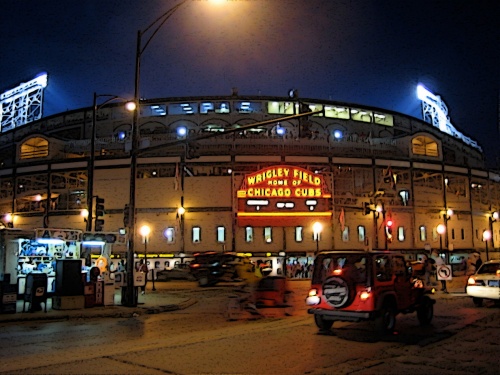 -- Wrigley Field -- Wrigley Field is a baseball park on the North Side of Chicago, which is the home of the Chicago Cubs, one of the city's two Major League Baseball (MLB) franchises.
-- Wrigley Field -- Wrigley Field is a baseball park on the North Side of Chicago, which is the home of the Chicago Cubs, one of the city's two Major League Baseball (MLB) franchises.
Attractions
 -- Chicago Water Tower -- The Chicago Water Tower now serves as a Chicago Office of Tourism art gallery known as the City Gallery in the Historic Water Tower. It features the work of local photographers and artists.
-- Chicago Water Tower -- The Chicago Water Tower now serves as a Chicago Office of Tourism art gallery known as the City Gallery in the Historic Water Tower. It features the work of local photographers and artists.
Bars and Clubs
- -- Blue Velvet -- Anarch Hangout.
- -- Succubus Club -- Duh
- -- The Cave --
- -- Ponytail Club -- A notorious strip-club catering to female clients. (Owned by Bret Stryker)
Cemeteries
City Government
The mundane government of Chicago is still controlled by the old political machine--a political machine unrivaled in any other city in the nation. Though it was overthrown for a time by the extraordinary black politician, Mayor Harold Washington, the manipulations of the Kindred allowed the machine to take over again a few years later.
To this day the machine permeates down to the neighborhood level. Ward bosses look out of the voters in their neighborhoods and pass out political favors to those who aid them. Vampiric dominance of this process no longer exists. Lodin's death freed many of these bosses to act on their own, without the undead to say yes or no. Individual vampires have seized individual wards, and even Lodin's former ghouls are rumored to be involved.
The prime powers of the city--mayor, aldermen, city attorney, congressmen, etc.--used to be under Lodin's influence. Cainites are still jostling for control of these individuals, but the mortals are beginning to fall into the different camps and, without a prince, may well turn the city's government into even more of a gridlock than it is today.
Crime
In Chicago crime is a business, and business is good. In a city of multi-cultural style, crime is no different: Organized Crime in Chicago is mostly run by "The Outfit". There are also gangs of every color and nationality. From before the Civil War there have been members of the Ku Klux Clan in Chicago, giving rise to the white supremacist movement and the white gangs. Chicago crime has become infamous for the rise of the black gangs and their violence. There is also a strong Asian community here, run by the Wing Chung, Triads, and Tongs. The Jamaican gangs have begun to be a force. Last but not least are the barrio hispanic gangs.
Citizens of the City
- -- Arvel Ingham -- Chicago Beat cop at Wriggly Field
- -- Asun Reyes -- Chicago Beat cop at Wriggly Field
- -- Ke'denn -- Half-black crackhead that Tremen rolled for information.
- -- Massoud "Roshan" Charmchi -- Persian (Iraqi) gun dealer.
- -- Captain Eurehl Bonner -- Chief of Chicago's narcotics division.
- -- The Hall Family of Chicago
Current Events
Galleries
Holy Ground
- --First United Methodist Church Chicago Temple
- --Fourth Presbyterian Church
- --Holy Trinity Orthodox Cathedral
- --Old St. Patricks' Church
- --St. Mary of the Angels
- --The Orthodox Temple of Akhenaton
- --The Temple of the Fanum
Hospitals
- -- Chicago University Hospital
- -- University of Chicago Medical Center
- -- La Rabida Childrens Hospital
- -- Mount Sinai Medical Center
- -- Mercy Hospital and Medical Center
- -- Northwestern Memorial Hospital -- (NMH) is a nationally ranked academic medical center hospital located in downtown Chicago.
- -- University of Chicago Medicine
- -- Chicago-Read Mental Health Center -- Formerly known as: Cook County Insane Asylum.
Hotels & Motels
- -- Warwick Allerton - Chicago -- The Warwick Allerton - Chicago (formerly Allerton Hotel and Warwick Allerton Hotel Chicago and Allerton Crowne Plaza Hotel) is a 25-story 360 ft (110 m) hotel skyscraper on the Magnificent Mile in the Near North Side community area of Chicago.
Landmarks
- -- 300 West Adams Building --
- -- 333 North Michigan --
- -- 35 East Wacker --
- -- 42nd Precinct / Town Hall Police Station --
- -- 63rd Street Bathing Pavilion --
- -- 860-880 Lake Shore Drive --
- -- Dr. Wallace C. Abbott House --
- -- Adams House --
- -- All Saints Church and Rectory (Ravenswood, Illinois) --
- -- Warwick Allerton - Chicago --
- -- Alta Vista Terrace District --
- -- American School of Correspondence --
- -- American System-Built Homes --
- -- Arlington and Roslyn Place District --
- -- Armitage-Halsted District --
- -- [[]] --
- -- [[]] --
- -- [[]] --
- -- [[]] --
- -- [[]] --
- -- [[]] --
- -- [[]] --
- -- [[]] --
- -- [[]] --
- -- [[]] --
- -- [[]] --
- -- [[]] --
- -- [[]] --
- -- [[]] --
- -- [[]] --
Law Enforcement
Mass Media
Monuments
Museums
Parks
Places of Note
Private Residences
Restaurants
Ruins
- -- Chicago Underground -- The Chicago Tunnel Company built a 2 ft (610 mm) narrow gauge railway freight tunnel network under the downtown of the city of Chicago from 1899 to 1903. This was regulated by the Interstate Commerce Commission as an interurban despite the fact that it operated entirely under central Chicago, did not carry passengers, and was entirely underground. It inspired the construction of the London Post Office Railway.
Schools
- -- Alder School of Professional Psychology
- -- Chicago State University
- -- Chicago Theological Seminary
- -- University of Chicago
Shops
Theaters
Transportation
- -- O'Hare International Airport -- Chicago O'Hare International Airport (IATA: ORD, ICAO: KORD, FAA LID: ORD), also known as O'Hare Airport, Chicago International Airport, Chicago O'Hare or simply O'Hare, is an international airport located on the Far Northwest Side of Chicago, Illinois, 17 miles (27 km) northwest of the Loop. It is the primary airport serving the Chicago metropolitan area, with Midway International Airport, about 10 miles (16 km) closer to the Loop, serving as a secondary airport. It is operated by the City of Chicago Department of Aviation.
Supernaturals of Chicago
Chicago Chronicles 3: The Undead of the Faceless City
Chicago Tonight: May 1st, 2003
Ten years have passed since werewolves attacked the Kindred of Chicago, killing one third of the city's undead, among them the then Ventrue Prince - Lodin. With the prince's death, authority passed to the Council of Primogen, that body of elders ended the "Blood Moon War" with great difficulty and in doing so set the stage for a Kindred only conflict - the war for Chicago's throne. In the immediate aftermath of the Kindred-Lupine war, the undead of Chicago struggled to put the pieces of their shattered unlives and the Masquerade back together. Only once before had the vampires of Chicago been witness to so many final deaths, during the Great Chicago Fire of 1871. Nearly all of the Kindred of the Windy City had discovered a newfound sense of mortality, for while the undead are ageless, their cursed immortality had proven to be surprisingly fragile.
 The Camarilla Court of Chicago
The Camarilla Court of Chicago
- -- Maxwell -- The Rabble Prince of Chicago
- -- Critias -- Ancient Athenian of Chicago's Rabble
- -- Inyanga -- Beast-woman and Ancient Outlander
- -- Bryan Lund -- Elder Lunatic of the Windy City
- -- Khalid al-Rashid -- Middle Eastern Master of the Sewer Rats
- -- Annabelle Triabell -- Prima Donna of Chicago's Degenerates
- -- Nicolai Antonescu -- Child Regent of the Warlocks
- -- Rebekah -- The Ancient Dowager of Chicago's Collective Blue Bloods
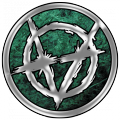 Clan Brujah
Clan Brujah
The Brujah of Chicago are a very diverse group, including anarchs and elders, friends of the Ventrue and friends of no one. They fight each other as much as they fight the other clans, but it is precisely this sort of conflict that marks the Brujah Clan and brings out the best in its individual members.
Although the Brujah of Chicago do not have regularly scheduled meetings of any sort, they do gather on occasion. When one of them calls for a meeting, the others will usually come, but very little is usually achieved. Meetings are held in a variety of places, as much according to whim as anything else. The back room of a bar is common meeting place, as is a cemetery or a condemned building.
At these meetings, the Brujah pretend friendliness with one another -- at least until the arguments and recriminations begin. They seem to enjoy their "Rants," as they call them. Often, one or two of them will leave in a terrible mood, having been targeted by all the rest for ridicule and abuse. Indeed, picking out scapegoats for each Rant seems to be the only thing upon which they can ever agree.
Many of the younger Brujah want everyone in the clan to join the anarchs. However, the three eldest -- Critias, Maxwell and Balthazar -- have their own plans, which do not allow for such radical action. The end result is that the Brujah of Chicago remain divided, but continue to debate with great gusto and relish. Each, in his or her own way, is proud of being Brujah, and most are proud of the fact that they have members in almost every coterie in the city, considering this proof of great open-minded-ness.
An old vampiric adage has it that Brujah have nothing in common but their differences, and those of Chicago certainly show the truth of this saying. In times of conflict, these Brujah have absolutely no scruples about attacking one another, although, feuds are suspended during Rants.
- -- Critias -- Elder Philosopher of Chicago's Rabble
- -- Damien -- Athlete, Neonate, Student and Casanova.
- -- Maxwell -- The Once and Again Prince of Chicago
- -- Reynaud Laurent -- Maxwell's eldest and most trusted childe, the "Frenchman" serves as his sire's right-hand-man and personal advisor.
- -- Rodolfito Cuevas -- The "Cuban" was a famous bandit turned revolutionary who became Maxwell's childe after his 1871 ouster.
- -- Absolon Berger -- The "Haitian" was Maxwell's second childe after his displacement, as a scholar he became Maxwell's companion during the late 19th century.
- -- Nuria Anastasia Vela -- A sophisticated Mexican beauty from Veracruz who caught Maxwell's eye, she was "given" to him as a gift in compensation for his loss of Chicago by Lodin's sire Datura.
- -- Bernardino Quintana -- Bernardino is fiery Mexican revolutionary Embraced by Maxwell just before the Mexican-American War.
- -- [[]]
- -- [[]]
- -- Joshua Tarnopolski --
- -- Anita Wainwright --
- -- Genghis --
- -- Juggler -- Anarch Leader of Gary, Indiana.
- -- Amara Frost --
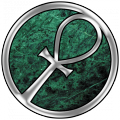 The Caitiff of Chicago
The Caitiff of Chicago
Once again the Caitiff were the first to die; the Lupine attack destroyed almost all of Chicago's clanless. Now, the Caitiff have little or no organization. Other than the fact that all are anarchs and belong to one anarch coterie or another, they have very little to do with one another. They share no common sense of identity and tend to hold the entire clan concept in contempt. To them, this is the modern age and clans are no longer of any import.
- -- Maldavis
- -- Dickie
- -- Jasper Krevets
- -- Raymond Wallace
- -- Victoria Longwood
- -- Moira Darling
 Clan Gangrel
Clan Gangrel
Chicago's Gangrel weathered the Lupine attack better than any of the other clans, but have gone through even more substantial changes in the last few years. Once very well organized, the individual Gangrel have begun to behave as Gangrel often do, becoming more reclusive and less inclined to congregate. They have not met as a clan in more than a year, and are unlikely to do so in the near future.
They have also become less involved in the city's politics. They used to play a stabilizing role in the city, pushing it away from anarchy and towards order. Now, when the city needs someone to keep it steady, the Gangrel are less able to play that role. Other clans have begun to suspect them of treachery, for they played such a small role in fighting the Lupines. Were it not for the powerful bonds keeping them in the city, most of the Gangrel would already have left Chicago for good.
- -- Inyanga -- Wise Woman of the Outlanders
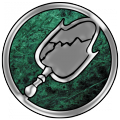 Clan Malkavian
Clan Malkavian
The Malkavians of Chicago have never failed to confuse and befuddle the city's other Kindred, and now they have done it again. Just when everyone believed they were safe in assuming the "Lunatics" were too mad to play a major role in the city, three new ones show up to disprove that, and those who survived the Lupine attack have evinced new interest in politics as well.
In the year following the "Blood Moon War", an elder Malkavian named Bryan Lund was able to ascend to the position of Chicago's primogen of Lunatics. While he has been the first to achieve this feat, his absenteeism from many of the city's most important political and social functions makes many wonder who is the actual power behind the new primogen, for Bryan Lund came to the city with two childer -- Bronwyn Blackbourne and Corbin Towner. Both spend far more time in Elysium that their sire and both are active in the undead politics of the city.
Rumors circulate among the harpies and throughout Elysium that one or the other of Lund's childer might one night soon succeed him. For now, they are the city's biggest wild card, but then, isn't that always true of the Malkavians?
- -- Bryan Lund -- The Quiet Lord of Lunatics
- -- Bronwyn Blackbourne
- -- Corbin Towner --
- -- Bronwyn Blackbourne
- -- Hubert Otis -- Final childer of Maureen O'Leery.
- -- Caroline Irene Parrish -- Final childer of Maureen O'Leery.
- -- Loren Annika Reese -- Maureen O'Leery's final, unclaimed and unauthorized childe.
- -- Even Klein -- Childe of Son & the Only surviving grandchilde of Maureen O'Leery.
- -- Michael
 Clan Nosferatu
Clan Nosferatu
The Nosferatu were once the most unified clan in Chicago, but no more. Many of its members were destroyed in the Lupine attack, and the remainder have few common interests. Khalid, who used to serve as their leader and who had earned the trust of all the "Sewer Rats," can no longer bring them together. Indeed, he suspects that there are far more Nosferatu in the city than even he has been able to detect.
- -- Khalid al-Rashid -- The King Rat
- -- Tammy Walenski --
- -- Nathaniel Bordruff
- -- Cedrick Calhoun
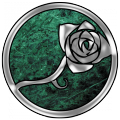 Clan Toreador
Clan Toreador
Chicago's Toreador generally draw disdain, both from other Kindred in the city and Toreador elsewhere.
Despite their protests, the Toreador of Chicago have been categorically labeled Poseurs, and draw scorn from their more artistic brethren. Other Kindred in the city see them as degenerate fops who desire only to preen and posture.
What none of these groups realize is that Chicago's Toreador are, Kindred for Kindred, the most powerful vampires in the city. None can match them for raw power, for while the weaker clan members died in the Lupine attack, the strong survived and benefited from the experience. When they make their move, the very pillars of the city will shake.
- -- Annabelle Triabell -- Matron of Roses
- -- Bret Stryker
- -- Eletria
- -- Kathy Glens
- -- Portia
 Clan Tremere
Clan Tremere
The Tremere are easily the most organized clan in the city. Its members share common objectives and work closely together to achieve those objectives. However, the clan leader, perhaps as a result of his youthful appearance, does not have the full respect or obedience of the other Tremere in Chicago.
The Council of Seven's interest in Chicago has increased following the events of the "Blood Moon War," and they have sent a Gargoyle agent to help protect the chantry -- and keep an eye on things.
In many ways, the clan elders see those Tremere in Chicago as expendable probes, intended to find out what is going on, but not expected to bring any other benefits to the clan. They know full well that Nicolai is being controlled by someone powerful, likely and elder, but perhaps even a Methuselah or demon are possibilities, they do not know the identity of this entity...yet.
- -- Nicolai Antonescu -- Grand Magus of Warlocks
- -- Abraham DuSable
- -- Eric Weiss
- -- Erichtho
- -- Ublo-Satha -- Gargoyle Guardian of the Chicago Chantry
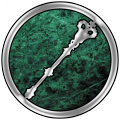 Clan Ventrue
Clan Ventrue
After Lodin's final death during the "Blood Moon War," the Ventrue of Chicago presented a united front. But, with several contenders present in the city ready to assume the mantle of his authority, their facade of unity began to crumble. Worse still, all the contenders for clan leadership were progeny of Lodin and all had a previous history of conflict with their siblings, which only Lodin could keep from erupting into open warfare. The two strongest contenders: Ballad and Capone were considered the mostly likely residents of Chicago to become prince, but their constant feuding made that possibility less and less likely. The remaining members of the clan jockeyed for position and their political maneuvering brought the clan to the brink of open hostilities. For the better part of a decade following Lodin's death, these conflicts continued unabated and prevented the clan from providing the kind of leadership that the city needed to emerge from its continuing spiral of decline.
That is until the appearance of Rebekah in late 1999. Rebekah was a foreign elder, originally from the Middle East, but who had traveled the globe for centuries before arriving in Chicago. A Ventrue of significant age and power, she chose to settle in Chicago with the permission of the city's Primogen, and almost immediately began to take control of her clan's affairs in the Windy City. At first there was considerable resistance to her influence, in part because she was not a member of Lodin's bloodline and in part because she was a woman. Neither of these apparent handicaps slowed Rebekah in the least and within a year of her arrive in Chicago, most of the city's Blue Bloods had come to accept her leadership of Ventrue affairs. Shortly thereafter, she was accepted among the Primogen of Chicago as an equal, but thereafter threw the council into disarray when she revealed damning and incontrovertible evidence of the Brujah Tyler's diablerie of Critias' childe Procet during the Council Wars of 1987. While this revelation initially caused strife among the council that threated the city's stability, but ultimately the truth created a bond between Critias and Rebekah, which has yet to mend the ancient rift between the Clans Brujah and Ventrue in Chicago.
- -- Rebekah -- The Red Queen
- -- Ballard -- Tycoon & Glutton
- -- Alan Sovereign -- Financial Genius
- -- Capone -- Mafia Capo & 1920s Gangster
- -- Harold Goodston -- Pariah, Abomination
- -- Jacob Schumpeter -- Tycoon Wannabe
- -- Kevin Jackson -- Leader of the Bloods Gang in Chicago
- -- Joseph Peterson -- Media Mogul
- -- Bobby Weatherbottom -- Computer Hacker {The Hurricane}
- -- Lorraine Matthews -- Trust Fund Baby
The Independent Clans of Chicago
 Followers of Set
Followers of Set
For decades, Chicago has been a place of interest to the Followers of Set, but Prince Lodin made it abundantly clear that no "Serpent" would ever reside in his city, and his "justice" was especially harsh in regard to the Followers of Set. That was so, until the Lodin was destroyed by the Lupines in 1993 and a enterprising neonate named Marcel Marchand made his way to the Windy City. Marcel immediately presented himself to the Council of Primogen and asked to become a resident, when he was told that all of the best hunting grounds were already accounted for, he smiled and asked for domain in the worst neighborhood of Chicago, and since no one else wanted the poor and violent district of Bronzville, it was given to him.
As the only Follower of Set in Chicago, Marcel found himself beset by antagonists and enemies, but due to the reputation of his clan there were an equal number of Kindred who wished to take advantage of his "services". Marcel for his part was only too happy to oblige and quickly found a niche in Chicago that only he can fulfill. While he does peddle drugs, specifically cocaine, he has made inroads into the other vices of Chicago as well, pandering to the dark and dirty desires of the city's mortal and immortal population alike. In this regard, he has come into conflict with both Al Capone and Kevin Jackson, both of whom consider themselves the criminal elite of Chicago and have taken offense at Marcel's influence in the vice trade, if they knew the truth, they would be more than offended.
Marcel who styles himself the Kindred prince of darkness, has attracted considerable attention from those within his clan and while only a few in Chicago know, he has established a temple in Bronzville and sired a childe. While that would certainly sour the attitudes of a number of Kindred in Chicago, worse still, he has secured a place in Chicago for two more Setites who are soon to arrive and aid him in a lucrative trade in vice and favors that now exceeds Marcel's very talented capacity. It seems that the Followers of Set have found a new home in Chicago and that they will continue to play a part in the ongoing struggles of the Kindred in the Windy City.
- -- Marcel Marchand -- French Setite Entrepreneur
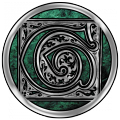 Clan Giovanni
Clan Giovanni
'
'
'
'
'
- -- Dr. Oliver Genet -- The Angel of Mercy
 Clan Ravnos
Clan Ravnos
'
'
'
'
'
- -- Shejana Cernik -- Gypsy survivor of the Holocaust.
Kindred Visitors to Chicago
'
'
'
'
'
- -- Torsten Metz -- Brujah Entrepreneur from Queens, New York City.
- -- Steven Clarke -- Setite Loyalist and former Gang-leader. {New York}
- -- Theirn Faucheux -- Setite Errand-boy {New York}
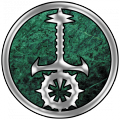 The Sabbat
The Sabbat
'
'
'
'
'
 Tyler -- Diablerist / Anathema / Sabbat Bishop Tyler -- Diablerist / Anathema / Sabbat Bishop(Patricia of Bollingbroke) |
The Fifth Column
 Phillipe Rigaud -- Gangrel Antitribu Phillipe Rigaud -- Gangrel Antitribu(Elder Sabbat Scout) |
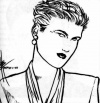 Wendy Wade -- Tzimisce Wendy Wade -- Tzimisce(Neonate Sabbat Scout) |
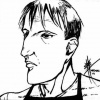 Doyle Fincher -- Gangrel Antitribu Doyle Fincher -- Gangrel Antitribu() |
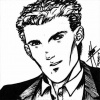 Edward Neally -- Ventrue Antitribu Edward Neally -- Ventrue Antitribu(The Prodigal Son) |
Daughters of Darkness
Daughters of darkness
Sisters insane
A little evil
Goes a long, long way
We stand together
No we're not afraid
We'll live forever
-- Halestorm, Daughters of Darkness
 Lolita Houston -- Tzimisce Ductus Lolita Houston -- Tzimisce Ductus() |
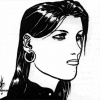 Margarite -- Pander Margarite -- Pander() |
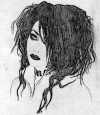 Belladonna -- Toreador Antitribu Belladonna -- Toreador Antitribu() |
 Deceased Vampires of Chicago
Deceased Vampires of Chicago
'
'
'
'
'
- -- Marianela Ubina -- Sire of Annabelle Triabell, former Primogen of Chicago, and often called by her diminutive Maria. -- R.I.P: 1990 (CoD: Unknown)
- -- Edward Neally -- R.I.P: 1991 (CoD: Unknown)
- -- Neil Graham -- R.I.P: 1993 (CoD: Lupine Attack)
- -- Hank Cave -- R.I.P: 1993 (CoD: Lupine Attack)
- -- Theodore Dooley (Dooley) -- R.I.P: 1993 (CoD: Lupine Attack)
- -- Mark Levesque -- R.I.P: 1993 (CoD: Lupine Attack)
- -- Travis Fett -- R.I.P: 1993 (CoD: Lupine Attack)
- -- Gordon Keaton -- R.I.P: 1993 (CoD: Lupine Attack)
- -- Priscilla Gibbs -- R.I.P: 1993 (CoD: Lupine Attack)
- -- Derrick Stack -- R.I.P: 1993 (CoD: Lupine Attack)
- -- Jimmy Holcomb -- R.I.P: 1993 (CoD: Lupine Attack) {Wraith}
- -- Jackie Goodman -- R.I.P: 1993 (CoD: Lupine Attack)
- -- Charles Waterstone -- R.I.P: 1993 (CoD: Lupine Attack)
- -- Paula Smith -- R.I.P: 1993 (CoD: Lupine Attack)
- -- Ben Smith -- R.I.P: 1993 (CoD: Lupine Attack)
- -- Horace Turnbull -- R.I.P: 1993 (CoD: Lupine Attack)
- -- Johann Weltmann -- R.I.P: 1993 (CoD: Lupine Attack)
- -- Elzbieta Jurofsky -- R.I.P: 1993 (CoD: Lupine Attack)
- -- Jurgis Rudkus -- R.I.P: 1993 (CoD: Lupine Attack)
- -- Peter Walenski -- R.I.P: 1993 (CoD: Lupine Attack) {Wraith}
- -- Tommy Walker -- R.I.P: 1993 (CoD: Lupine Attack)
- -- Sophia Ayes -- R.I.P: 1993 (CoD: Lupine Attack)
- -- Sharon Payne -- R.I.P: 1993 (CoD: Lupine Attack)
- -- Michael Payne -- R.I.P: 1993 (CoD: Lupine Attack)
- -- Sir Henry Johnson -- R.I.P: 1993 (CoD: Lupine Attack)
- -- Tamoszius Kuszleika -- R.I.P: 1993 (CoD: Lupine Attack)
- -- Garwood Marshall -- R.I.P: 1993 (CoD: Lupine Attack)
- -- Lodin -- R.I.P: 1993 (CoD: Lupine Attack)
- -- Tommy Hinds -- R.I.P: 1993 (CoD: Lupine Attack)
- -- Edgar Drummond -- R.I.P: 1993 (CoD: Lupine Attack)
- -- Laurence Ballard -- R.I.P: 1993 (CoD: Lupine Attack)
- -- Frank Gaughan -- R.I.P: 1993 (CoD: Lupine Attack)
- -- Pham Hong -- R.I.P: 1993 (CoD: Lupine Attack)
- -- Brennon Thornhill -- R.I.P: 1993 (CoD: Lupine Attack)
- -- Prias -- R.I.P: 1993 (CoD: Lupine Attack)
- -- Karl -- R.I.P: 1993 (CoD: Lupine Attack)
- -- Jason Newberry -- R.I.P: 1993 (CoD: Diablerized by Dr.Tremen Hall)
- -- Balthazar (Sheriff) -- Deceased: June of 2003 {CoD: Diablerized by Tremen Hall}
- -- Maureen O'Leery -- Deceased: June of 2003 (Cod: Diablerized by someone...could be Maxwell)
- --
Chi-Town Errata
- -- Chicago's War for the Prince
- -- Lodin’s Boardroom
- -- Lodin's Laws
- -- The Succubus Club
- -- Stories of Chicago's Undead
- -- May 5,2017
The Methuselah and the War of Ages
'
'
'
'
'
Ghouls
'
'
'
'
'
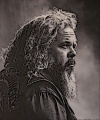 MacCarthy -- Member of the Straight-razor Biker gang (free ghouls) -- The gang that kidnapped Steven Clarke.
MacCarthy -- Member of the Straight-razor Biker gang (free ghouls) -- The gang that kidnapped Steven Clarke.
Changlings of Chicago
Ghosts of Chicago
Chicago is as cosmopolitan a city as North America can boast, but it out does itself where the supernatural are concerned. It seems for reasons unknown, that Chicago is a supernatural crossroads where any of the awakened might be encountered upon its sidewalks, in its nightclubs or its boardrooms. This includes the Dead, also known as Wraiths or ghosts. The ghosts of Chicago are a diverse group made up of strong and independent individuals and small groups known as Circles. In the Shadowlands, the city is a well known hierarchy stronghold and a burgeoning necropolis that churns out both grave goods and troops for the Iron Throne of Stygia. But, nothing is that simple, especially not in Chicago. Personal goals and grudges often trump the pogrom of the Hierarchy or its struggles with the other Kingdoms of the Dead.
- -- Dennis Maxwell -- In life, he was a small-time hood for the Chicago mob. AKA: "The Carpenter"
- -- Peter Walenski -- R.I.P: 1993 (CoD: Lupine Attack) {Wraith}
Jason Newberry's Victims
- -- Silvia Félix -- 32 yrs - Attractive Hispanic woman
- -- Zackery Hampson -- 18 yrs - Black High School Athlete
- -- Radosław Adamczyk -- 13 yrs - Polish teen
- -- Jimmy Holcomb -- "Neon" -- 7 yrs -- Former vampire
- -- Ogden Becket -- 9 yrs -- most recent victim
Hunters
- -- Guadalupe Droin -- known on Hunter-net.org as Cabbie22
- -- Thea Ghandour
Mages of Chicago
- -- Lo Pan -- Chinese Sorcerer
- -- Household of the Jade Demon
- -- The Sepulcher -- is a chantry of the Hollow Ones, located in a haunted house in the city of Chicago.
Werewolves of the Windy City
- -- Arnold Thunderheart -- Child of Gaia leader
- -- Pricilla Whitebird -- Glass Walker
- -- Anna "Eyes of the Sun" Pelfrey
- -- Michael "Peers-at-the-soul" Charneco
Stories of the Windy City
- -- Unfinished Family Business -- A story concerning the Naga Raja physician and serial killer Tremen Hall. {Timeline: May of 2003}
Websites
http://en.wikipedia.org/wiki/Chicago
Sources
Year of the Scarab Trilogy
- -- Heralds of the Storm (book 1)
- -- Lay Down With Lions (book 2)
- -- Land of the Dead (book 3)


